Lesotho is a small, mountainous kingdom in Southern Africa. It is home to a diverse array of birds, from raptors to waterfowl. Lesotho has a diverse range of habitats, from grasslands to wetlands, which provide a home for a variety of species.
In this article, we will explore some of the interesting birds found in Lesotho, including their behaviors and habitats.
1. Cape Vulture
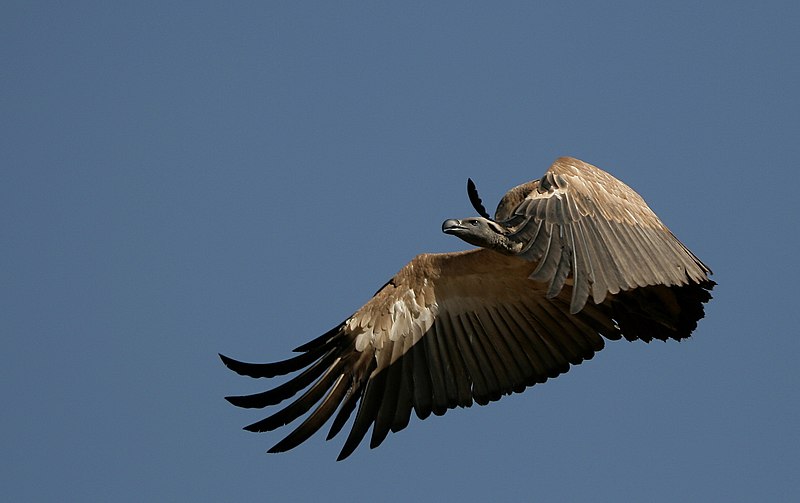
The Cape Vulture is an endangered Old World vulture found in southern Africa. It has also been called the Cape Griffon and Kolbe’s Vulture and lives mainly in South Africa, Lesotho, Botswana, and northern Namibia.
This species nests on cliffs and usually lays one egg per year.
Unfortunately its numbers have decreased drastically due to human activities such as loss of habitat or electrocution from power lines.
It was considered Endangered by IUCN until 2015 when it was down-listed to Near Threatened status thanks to conservation efforts that are helping preserve this majestic bird.Scientific classification:
| Kingdom | Animalia |
| Phylum | Chordata |
| Class | Aves |
| Order | Accipitriformes |
| Family | Accipitridae |
| Genus | Gyps |
| Species | G. coprotheres |
Also Featured In: Scavengers Birds You Should Know,
2. Cisticolidae
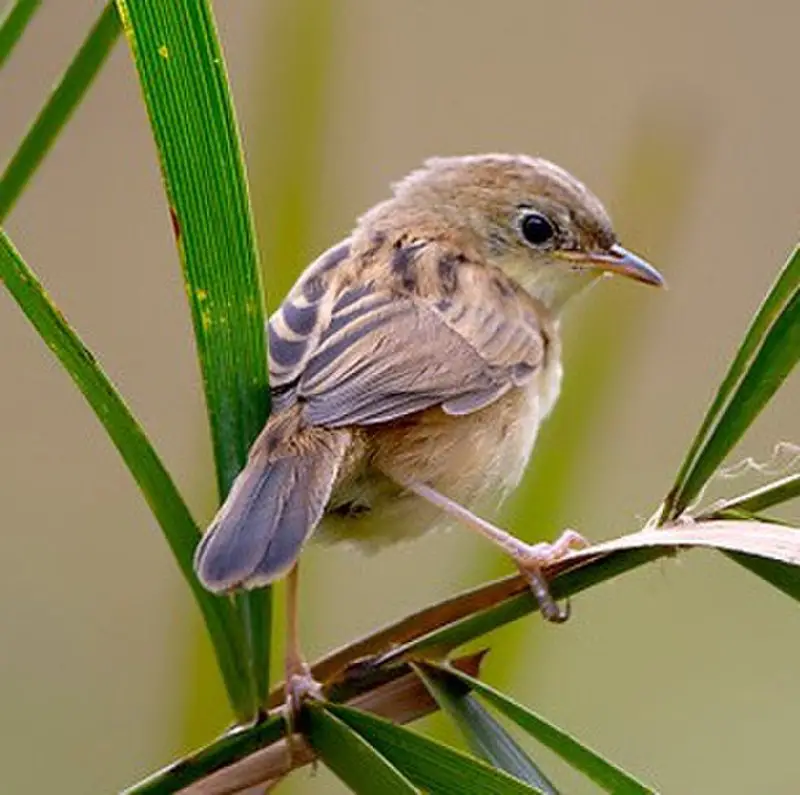
Cisticolidae is a family of warblers found mainly in warmer regions of the Old World. There are about 160 species all together, mostly seen across Africa but also in other parts like tropical Asia and Australasia.
One notable example from this family is the zitt bird which makes its home across these areas.
These small passerine birds have drab colors on their bodies with darker wings and tails for camouflage when they fly or perch among foliage.
They can be distinguished by their loud chirps that echo through forests and grasslands as well as distinctive songs used to attract mates during mating seasons.
Despite being quite common, Cisticolidae remain elusive due to their excellent ability to hide away within vegetation making them difficult to observe closely in nature.Scientific classification:
| Kingdom | Animalia |
| Phylum | Chordata |
| Class | Aves |
| Order | Passeriformes |
| Superfamily | Sylvioidea |
| Family | Cisticolidae Sundevall, 1872 |
Also Featured In: Birds of Sweden, Lebanon Birds Live in Semi-Desert Areas
3. Eurasian Reed Warbler
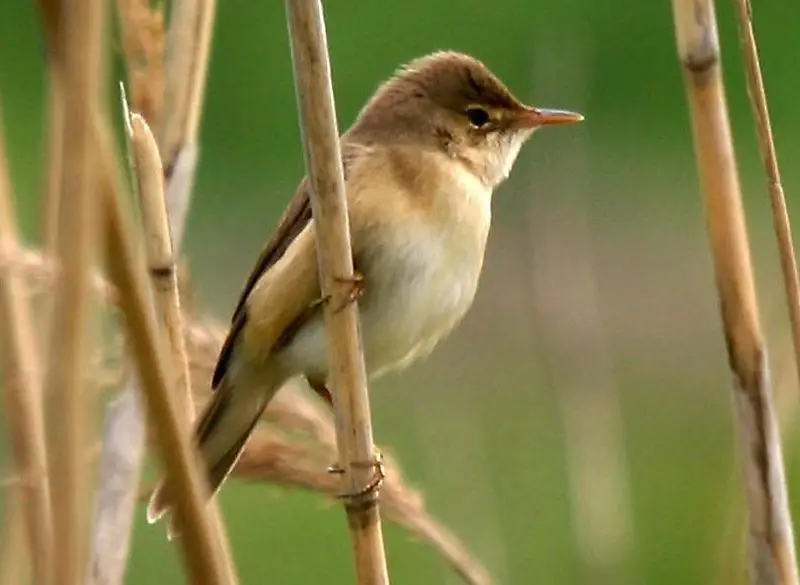
The Eurasian reed warbler (Acrocephalus scirpaceus) is a species of Old World Warbler native to the temperate parts of Europe and Asia.
It breeds in wetlands such as marshes, ponds and rivers with dense vegetation like reeds or tall grasses.
During its wintering season, it migrates southward to sub-Saharan Africa where there are milder conditions.
This small bird has streaked brown plumage on the upperparts and white underparts which makes it difficult for predators to spot among the foliage.
Its diet consists mainly of insects including aphids, caterpillars larvae and moths caught while flying over water or by gleaning from plants growing near water bodies.
The male sings an attractive song consisting of several phrases repeated one after another as part of their courtship display during breeding season in order attract females for mating purposes.Scientific classification:
| Kingdom | Animalia |
| Phylum | Chordata |
| Class | Aves |
| Order | Passeriformes |
| Family | Acrocephalidae |
| Genus | Acrocephalus |
| Species | A. scirpaceus |
4. Shrike
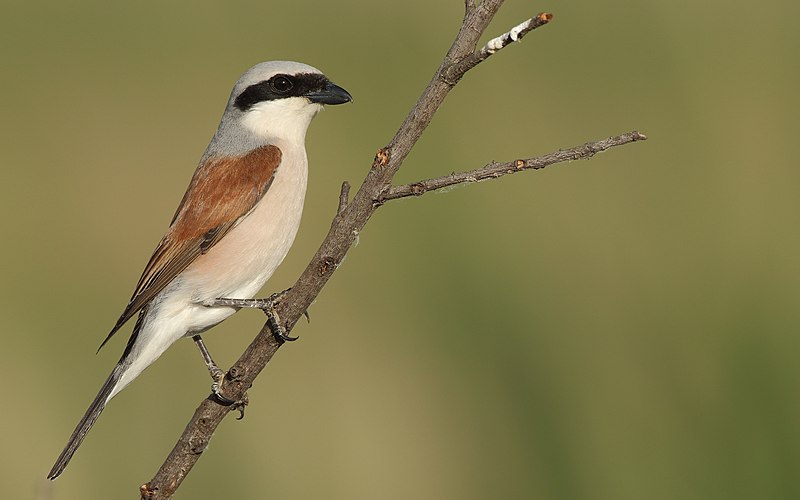
Shrikes are small passerine birds of the family Laniidae, with 34 species in four genera. They get their name from Old English word “scrīc”, which refers to their shriek-like call.
These birds have earned the nickname ‘butcherbirds’ due to their feeding habits; they impale prey on thorns or barbed wire fences for later consumption.
Shrikes also tend to be aggressive predators and hunt a wide range of animals such as insects, small reptiles, rodents and even other smaller bird species.
In terms of physical appearance, these songbirds can vary greatly depending on the specific genus but usually boast a large hooked bill atop an impressive crest along with bright colors like gray, black or brownish hues across its feathers.
It’s clear shrike is quite remarkable creature that has gained notoriety for both hunting prowess and distinctive vocalizations.Scientific classification:
| Kingdom | Animalia |
| Phylum | Chordata |
| Class | Aves |
| Order | Passeriformes |
| Superfamily | Corvoidea |
| Family | Laniidae Rafinesque, 1815 |
5. Sylviid Warblers
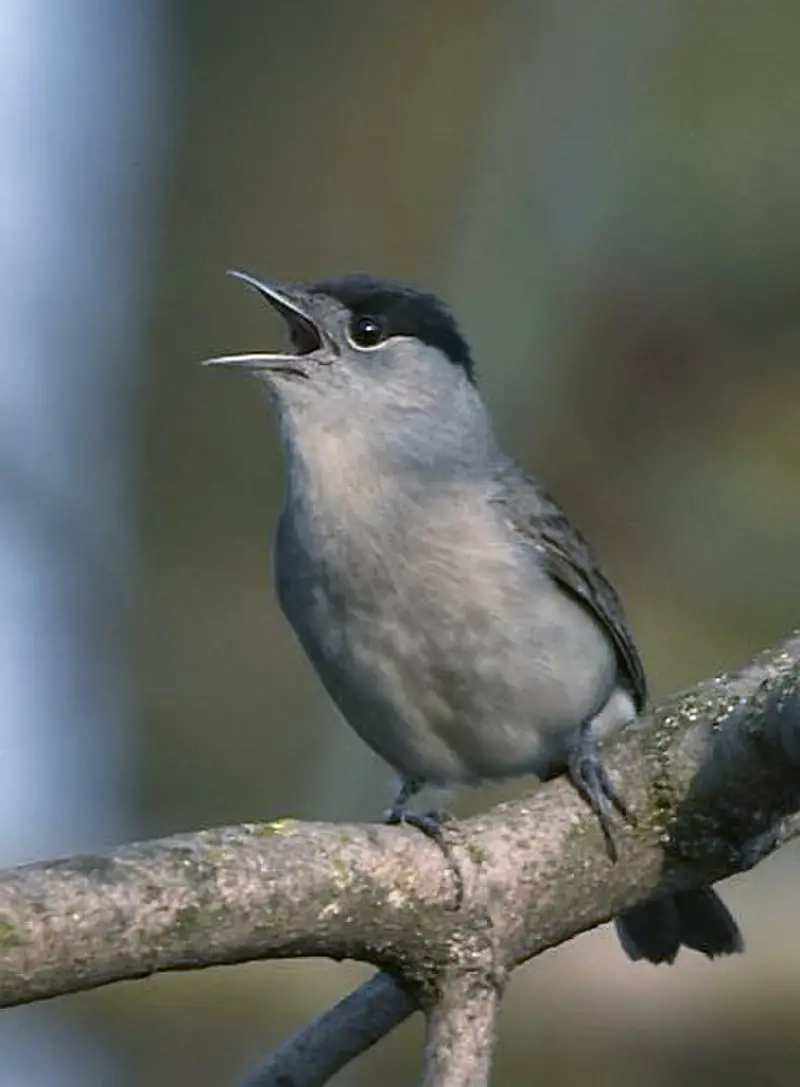
The Sylviid warblers are a family of passerine birds found in Eurasia and Africa. They include the typical warblers as well as babblers that were formerly part of the Old World babbler family.
These birds have slender bodies, pointed wings, long tails and strong legs adapted for ground-dwelling habits like running or hopping along branches.
The male often has bright colors while females are usually duller in coloration with more muted plumage patterns than males.
Some species also show sexual dimorphism where one sex may be larger or smaller than its counterpart; for instance some species may have longer tail feathers on the female side compared to their male counterparts.
Many members of this group feed on insects but some specialize on seeds, fruits, nectar or even frogs.Scientific classification:
| Kingdom | Animalia |
| Phylum | Chordata |
| Class | Aves |
| Order | Passeriformes |
| Superfamily | Sylvioidea |
| Family | Sylviidae Leach, 1820 |
6. Bushshrike
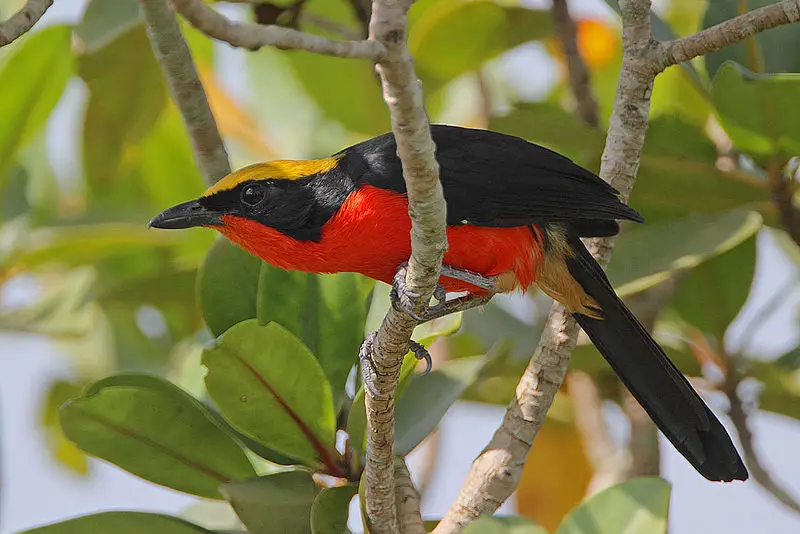
Bushshrikes are a family of small passerine birds native to Africa. Their ruffled back and rump feathers distinguish them from other shrike-like relatives, such as helmetshrikes.
They have bright plumages that vary in color depending on the species, but typically feature black wings with white or yellow markings.
Bushshrikes feed mainly on insects while also occasionally consuming fruits, berries and seeds.
They often hunt by perching atop tall trees and scanning for prey before swooping down upon their target when spotted.
During breeding season males sing melodious songs to attract mates while females build nests in dense foliage near the forest floor using sticks, leaves and grasses lined with soft mossy material or fur plucked from dead animals.Scientific classification:
| Kingdom | Animalia |
| Phylum | Chordata |
| Class | Aves |
| Order | Passeriformes |
| Superfamily | Malaconotoidea |
| Family | Malaconotidae Swainson, 1824 |
7. Sandgrouse
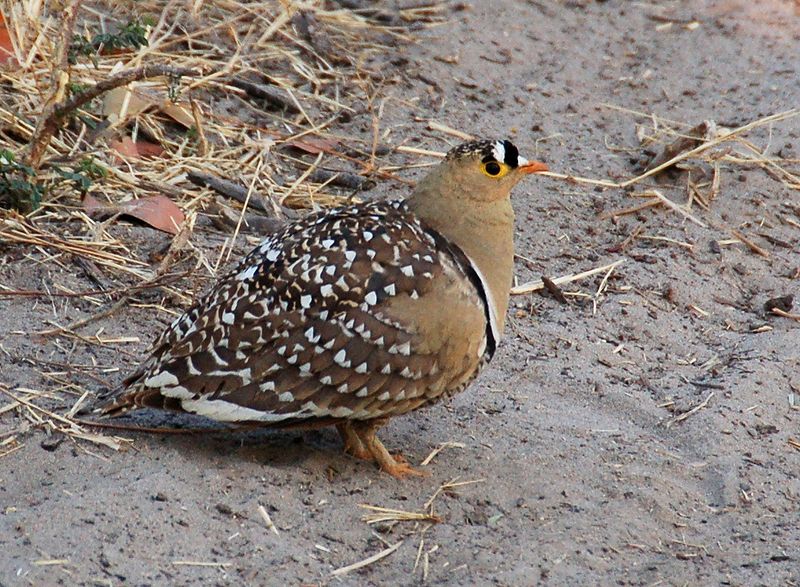
Sandgrouse is birds of the order Pterocliformes, found mainly in Africa and Asia. There are sixteen species belonging to two genera – Syrrhaptes from central Asia and Pterocles from Africa and other Asian countries.
They inhabit treeless areas such as deserts, steppes, scrubland, or savannas and tend to be ground-dwelling birds that feed on seeds.
Sandgrouse has adapted special features for survival in their harsh environment.
They possess well-developed feet with four toes used for walking over hot sand while keeping their body temperature cool at all times by regulating heat loss through their legs.
Their feathers also act like a sponge helping them absorb water before flying long distances back home where they then expel it using specialized glandular secretions located near the wings so that chicks can drink directly from an adult’s breast plumage.Scientific classification:
| Kingdom | Animalia |
| Phylum | Chordata |
| Class | Aves |
| Clade | Columbimorphae |
| Order | Pterocliformes Huxley, 1868 |
| Family | Pteroclidae Bonaparte, 1831 |
8. Bustard
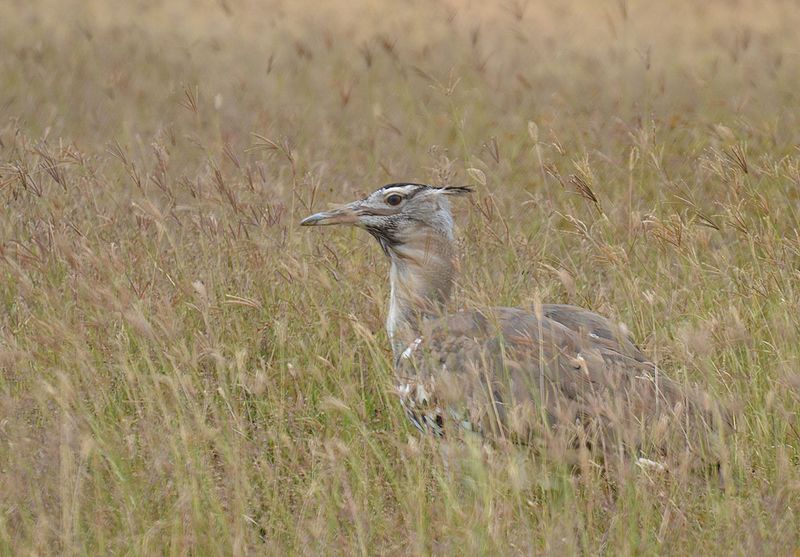
Bustards are large, terrestrial birds that inhabit dry grassland areas and the steppes of the Old World. They range from 40-150 cm in length and belong to the family Otididae.
Bustards have an omnivorous diet consisting of leaves, buds, seeds, fruit as well as small vertebrates and invertebrates.
These birds usually live a solitary life but can be seen gathering around water sources or food during certain times of year such as mating season.
Due to their large size they are vulnerable to predation by foxes or other animals which is why they tend to remain alert at all times.
When in open spaces while relying on camouflage for protection against predators when out in tall vegetation coverings.Scientific classification:
| Kingdom | Animalia |
| Phylum | Chordata |
| Class | Aves |
| Clade | Otidimorphae |
| Order | Otidiformes Wagler, 1830 |
| Family | Otididae Rafinesque, 1815 |
9. Mousebird
Mousebirds are a group of small, omnivorous birds found in Africa and the Middle East. They have long tails with white tips and black-tipped wings that give them their name.
Mousebirds feed mainly on insects, fruit, seeds and flowers but will also eat berries from bushes or trees.
They can be seen perched on branches or flying around looking for food during the day time.
Their nests are built out of twigs in hollows such as tree cavities or rock crevices where they lay eggs which hatch after about two weeks.
Mousebirds live in flocks so you may see several at once searching for food together.
During breeding season males show off to attract females by puffing up their feathers and displaying unique courtship behaviours like singing loudly to impress potential mates – it’s quite a sight.
10. White-Eyes
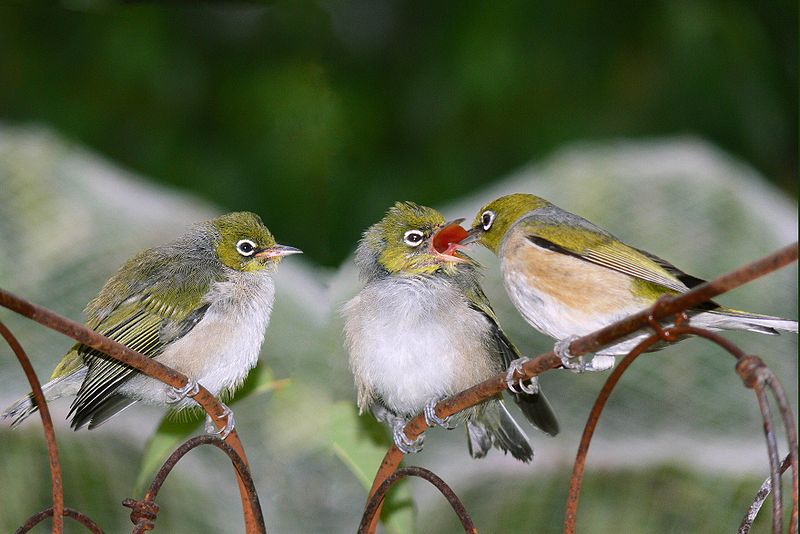
White-eyes are small passerine birds found in a variety of tropical, subtropical and temperate environments.
They inhabit most islands in the Indian Ocean, western Pacific Ocean and Gulf of Guinea.
The family Zosteropidae includes many species which are endemic to single islands or archipelagos – they can’t be seen anywhere else on Earth.
White-eyes have distinctive white feathers around their eyes giving them their name, while some also feature yellow plumage or bright red patches at the throat.
These pretty little birds feed mainly on insects such as beetles and caterpillars but will also eat nectar when available.
With their friendly nature, white-eyes make great garden visitors who often come close enough for you to watch up close with binoculars.Scientific classification:
| Kingdom | Animalia |
| Phylum | Chordata |
| Class | Aves |
| Order | Passeriformes |
| Superfamily | Sylvioidea |
| Family | Zosteropidae Bonaparte, 1853 |
11. Drongos
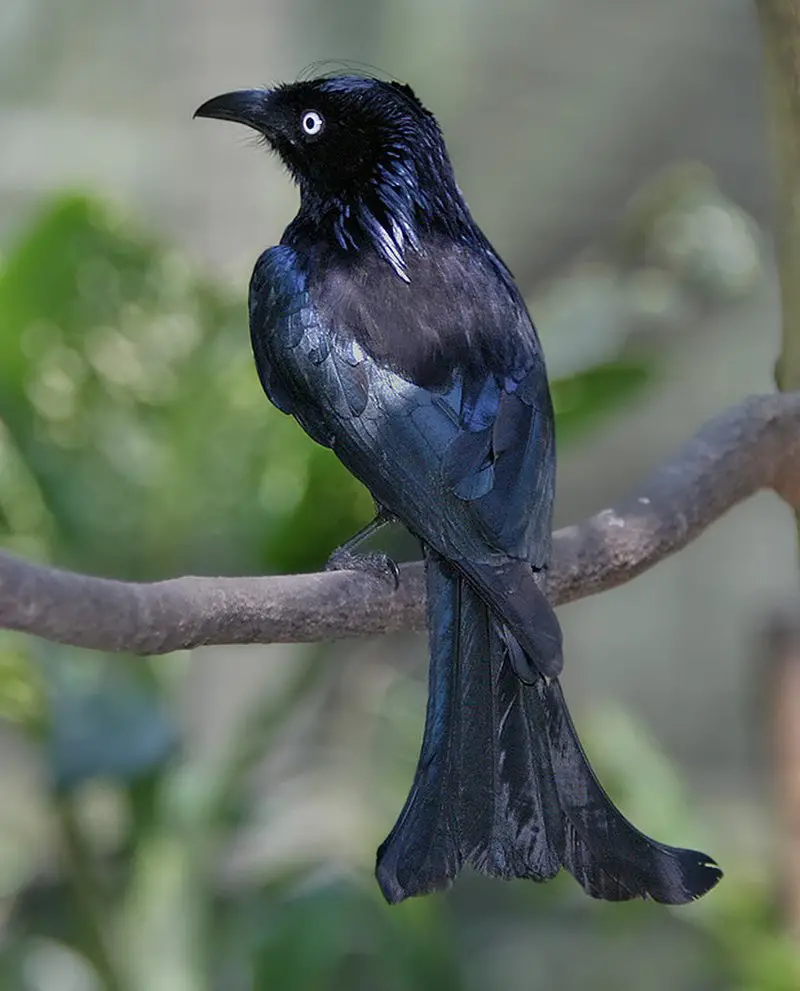
Drongos are an Old World tropical family of passerine birds belonging to the Dicruridae genus.
They have short legs, forked tails and a distinctive upright stance when perched.
Depending on the species they may be mostly black or dark grey in colour with some having elaborate tail decorations.
Drongos feed mainly on insects and small birds – catching them both in flight and from the ground.
They also sometimes eat fruit, nectar and even carcasses.
The drongo’s unique adaptations make it one of nature’s most successful hunters; able to survive almost anywhere in their natural range across Africa, Asia & Australia.Scientific classification:
| Kingdom | Animalia |
| Phylum | Chordata |
| Class | Aves |
| Order | Passeriformes |
| Superfamily | Corvoidea |
| Family | Dicruridae Vigors, 1825 |
| Genus | Dicrurus Vieillot, 1816 |
12. Wattle-Eye
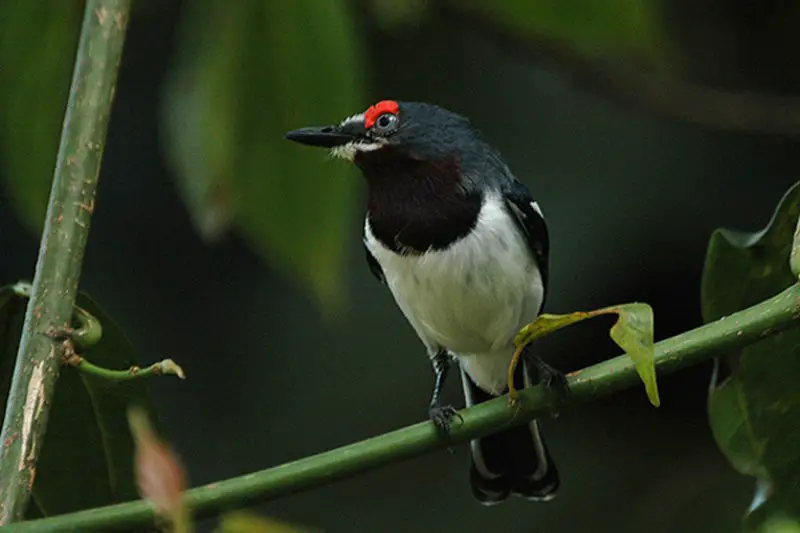
The wattle-eye, a member of the Platysteiridae family, is an insect-eating bird native to Africa.
It has a stout body and small head with bright yellow eyes surrounded by black patches or ‘wattles’.
They are usually seen in open forests or bushland where they hunt for insects either on the ground like shrikes do, or by flycatching from low perches.
Their nest is typically built in trees using twigs and leaves to form cup shaped structures lined with grasses and feathers which insulate their eggs during incubation periods.
Wattle-eyes can be recognised easily due to their distinct colours; males have greyish underparts while females display olive green hues with white speckled breast feathers that become more vibrant when breeding season begins.Scientific classification:
| Kingdom | Animalia |
| Phylum | Chordata |
| Class | Aves |
| Order | Passeriformes |
| Superfamily | Malaconotoidea |
| Family | Platysteiridae Sundevall, 1872 |
13. Jackal Buzzard
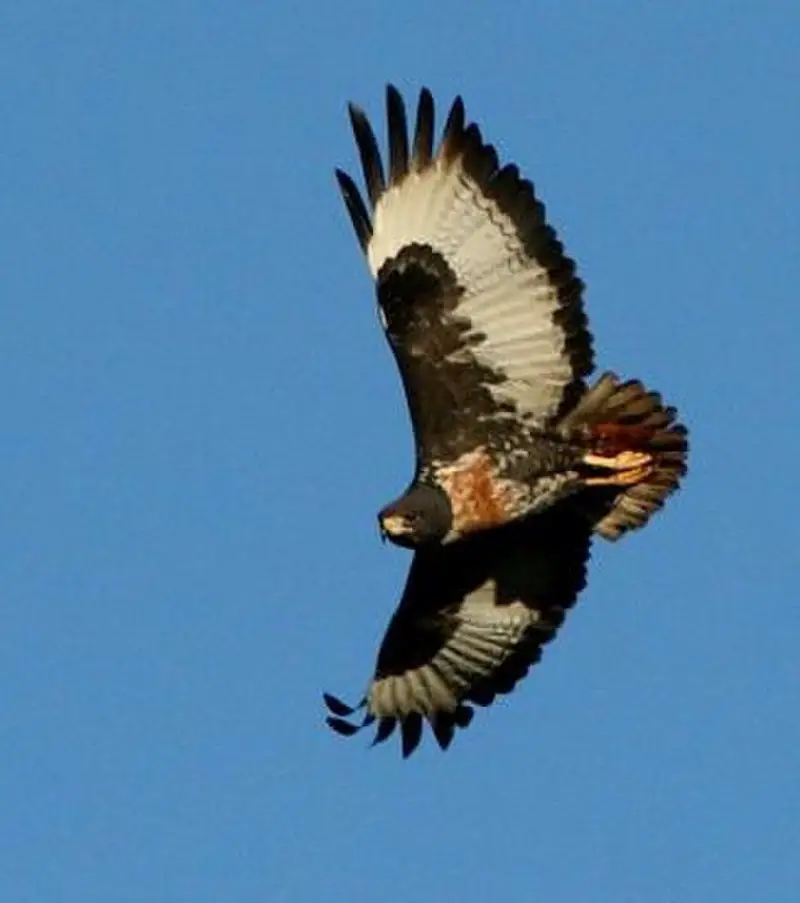
The Jackal Buzzard is a large African bird of prey that belongs to the Buteo species complex. It is sometimes considered the same superspecies as the Archer’s buzzard and Augur buzzard, although this remains under debate amongst taxonomists.
The Jackal Buzzard is mainly found in open grassland habitats where it hunts small mammals or reptiles for food.
It has a long wingspan with dark brown feathers on its upper side and light-colored underside.
Its face also features distinctive black stripes running down either side which help distinguish it from other birds of prey in its habitat.
Despite being classified as least concern by IUCN, their populations are declining due to human activities such as deforestation and hunting pressure so conservation efforts must be taken seriously if we want to ensure these magnificent creatures remain part of our planet’s biodiversity for many years to come.Scientific classification:
| Kingdom | Animalia |
| Phylum | Chordata |
| Class | Aves |
| Order | Accipitriformes |
| Family | Accipitridae |
| Genus | Buteo |
| Species | B. rufofuscus |
14. Painted-Snipe
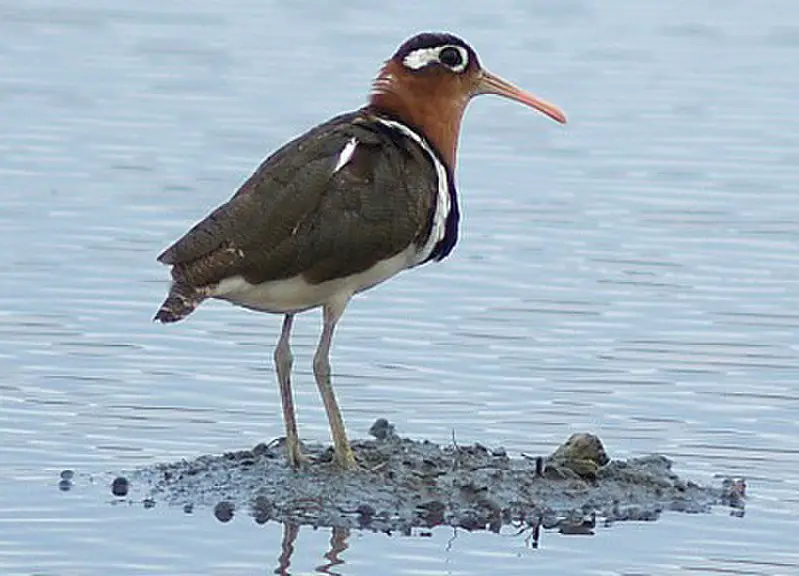
Painted snipes are beautiful and unique wading birds found in the Rostratulidae family. They have short legs, long bills, and a striking plumage which distinguishes them from true snipes.
Males tend to be smaller than females with duller overall coloration. There are three species of painted snipe.
The Greater Painted Snipe, Lesser Painted Snipe, and Australian Painted Snipe – all three have different habitats ranging from wetland pools to grasslands or mangroves depending on their region.
These birds feed mainly on earthworms but also consume insects, crustaceans and plant material when available.
As they rely heavily on wetlands for breeding purposes it is important that we protect these precious habitats so that this special bird can continue to thrive.Scientific classification:
| Kingdom | Animalia |
| Phylum | Chordata |
| Class | Aves |
| Order | Charadriiformes |
| Suborder | Thinocori |
| Family | Rostratulidae Coues, 1888 |
15. Glareolidae
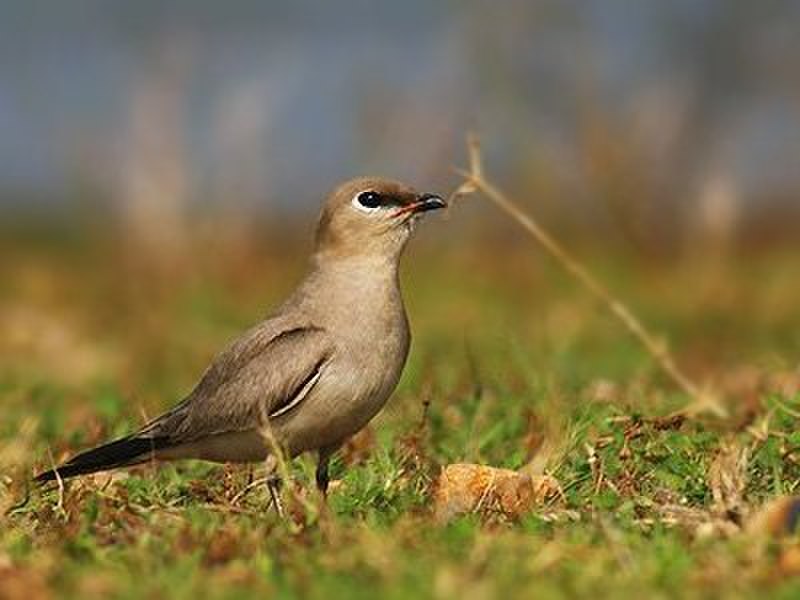
Glareolidae is a family of wading birds, consisting of four genera and 17 species. They are distinguished from other charadrii by their long bills which have a slight downward curve.
Glareolidae live around open grasslands and deserts, where they hunt for insects using the bill to probe into soil or vegetation.
Most species are found in Africa but two pratincoles inhabit parts of Europe and Asia as well.
Coursers tend to be larger than pratincoles with longer legs allowing them to run quickly across sandy dunes while feeding on small animals like lizards or spiders.
Pratincoles feed mainly on flying insects, snatching them out of midair with great agility during flight.
All glareolids share unique features such as large eyes that help it spot prey at night easily making this group one interesting bird family.Scientific classification:
| Kingdom | Animalia |
| Phylum | Chordata |
| Class | Aves |
| Order | Charadriiformes |
| Suborder | Lari |
| Family | Glareolidae CL Brehm, 1831 |
16. Malachite Sunbird
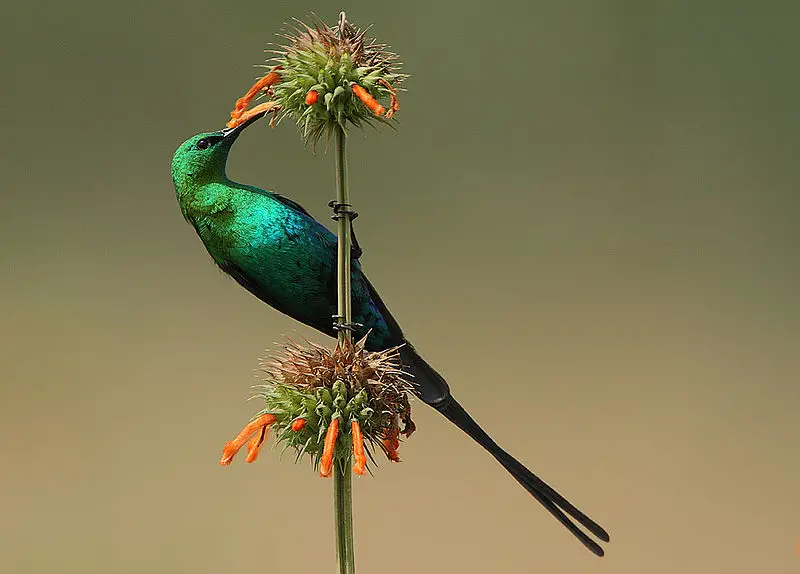
The Malachite sunbird is a small and beautiful bird found in the highlands of Ethiopia, right down to South Africa.
It loves nectar, particularly from plants that have long corolla tubes like those found in Fynbos regions.
This species belongs to the Nectariniidae family which spans across several parts of Africa and into Southeast Asia.
Its plumage is quite distinct with bright colors such as green on its upperparts and yellow-orange underparts.
The male usually has an iridescent blackish head while females are slightly more drabber but still show vibrant hues when seen up close.
These birds play an important role for pollinating many floral sources in their range making them essential members of any given ecosystem they inhabit.Scientific classification:
| Kingdom | Animalia |
| Phylum | Chordata |
| Class | Aves |
| Order | Passeriformes |
| Family | Nectariniidae |
| Genus | Nectarinia |
| Species | N. famosa |
17. Jacanas
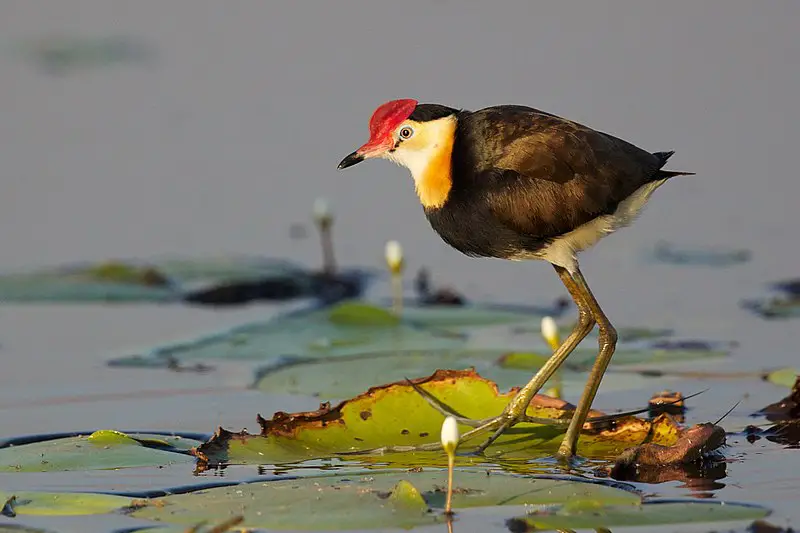
Jacanas are tropical waders belonging to the Jacanidae family. They have distinctive elongated toes and toenails which help them forage on floating or semi-emergent aquatic vegetation.
This adaptation gives them their nickname “Jesus birds” as they seem to be able to walk on water.
The female jacanas are also unique amongst bird species in that they take charge of nest building, incubation and caring for young while males perform courtship displays.
These unusual birds can be found throughout the world’s tropical regions where they inhabit wetlands such as swamps, marshes and shallow lakes with lily pads.
With a wide variety range due their special adaptations these beautiful creatures will surely continue living life at ease around our planet’s warmest waters.Scientific classification:
| Kingdom | Animalia |
| Phylum | Chordata |
| Class | Aves |
| Order | Charadriiformes |
| Suborder | Thinocori |
| Family | Jacanidae Stejneger, 1885 |
18. Stone-Curlew

Stone-curlews, also known as dikkops or thick-knees, are a family of birds that have adapted to live in tropical and temperate regions throughout the world.
They can be found in Africa, Asia and Australia with two or more species per region. Despite being classified as waders, most prefer dry arid habitats over moist wetlands.
Stone-curlews typically have long legs which help them navigate through their preferred terrain efficiently; some species even stand at an impressive height when standing on those long legs.
Additionally they feature cryptic plumage which helps them blend into their surroundings while hunting for prey such as insects and small mammals like rodents.
These unique bird’s calls are easily recognizable; it has been said that hearing one is similar to listening to someone whistling ‘Keee Weee’.Scientific classification:
| Kingdom | Animalia |
| Phylum | Chordata |
| Class | Aves |
| Order | Charadriiformes |
| Suborder | Chionidi |
| Family | Burhinidae Mathews, 1912 |
19. Honeyguide
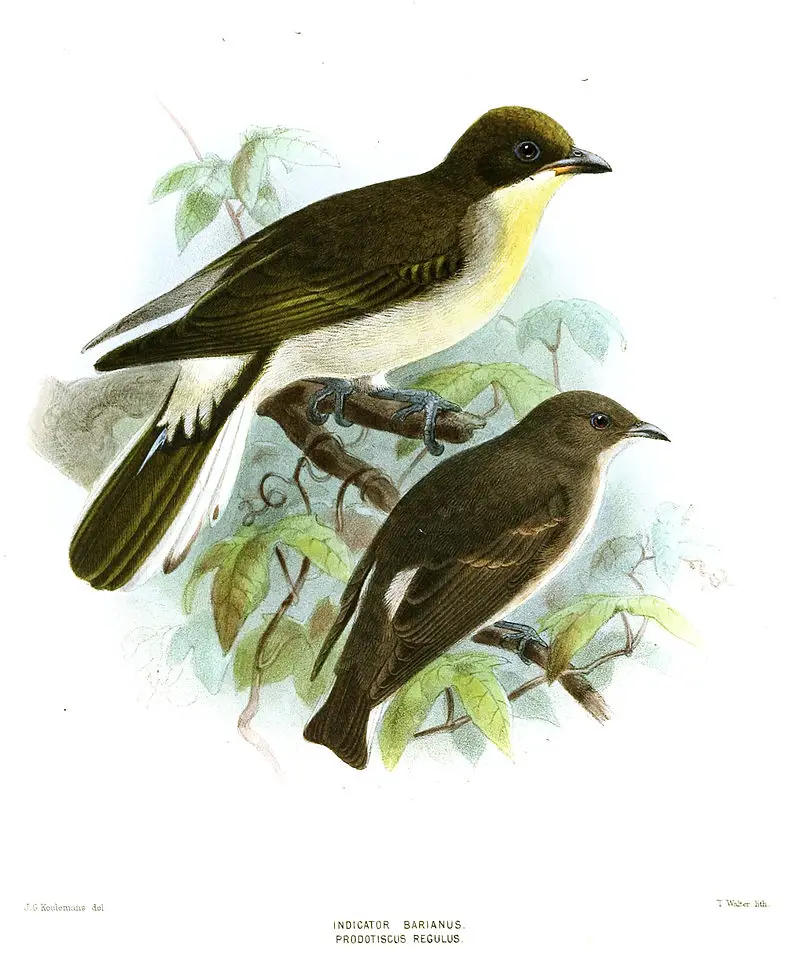
Honeyguides are small, near passerine birds belonging to the family Indicatoridae. Native to tropical regions of Asia and Africa, they’re best known for their unique relationship with humans.
They have a mutualistic association with people by leading them towards bee colonies in exchange for wax or honey from the hive after it has been opened up.
Honeyguide birds use special calls that sound like ‘tink-tink’ or ‘hweet hwuit’, which is thought to be their way of telling potential partners about food sources available nearby.
This remarkable ability makes them an invaluable resource for local communities and indigenous groups who rely on wild bees as a source of income and nutrition.Scientific classification:
| Kingdom | Animalia |
| Phylum | Chordata |
| Class | Aves |
| Order | Piciformes |
| Infraorder | Picides |
| Family | Indicatoridae Swainson, 1837 |
20. Stilts And Avocets
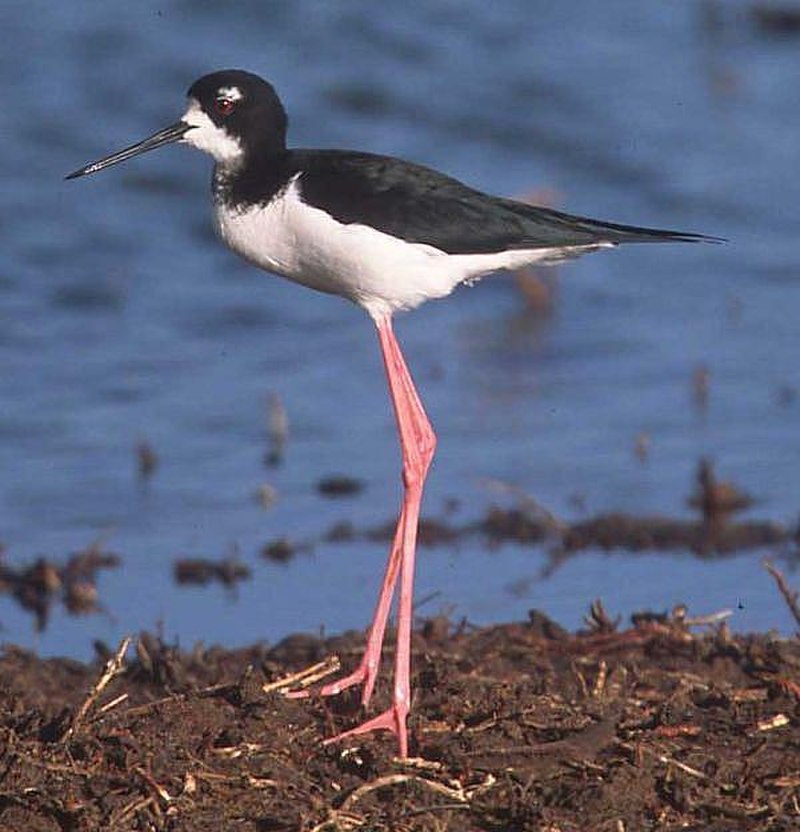
Stilts and avocets are two distinct groups of birds belonging to the family Recurvirostridae. They range in length from 30-46 cm (12-18 inches) and weigh between 140 – 435 g (4.9 – 15.3 ounces).
Males usually have slightly larger bodies than females, with long thin legs, necks and bills.
Avocet bills curve upwards uniquely while stilt beaks remain straight most times.
These wading birds live mainly near shorelines or wetlands where they feed on aquatic invertebrates like brine shrimp, insects etc., occasionally supplementing their diet with seeds or small fish too.
Stilts also inhabit open fields in search of food sources such as earthworms or grasshoppers during the non-breeding season.
Both groups migrate over large distances for warmer weathers when it gets cold outside.Scientific classification:
| Kingdom | Animalia |
| Phylum | Chordata |
| Class | Aves |
| Order | Charadriiformes |
| Suborder | Charadrii |
| Family | Recurvirostridae Bonaparte, 1854 |
21. Monarch Flycatcher
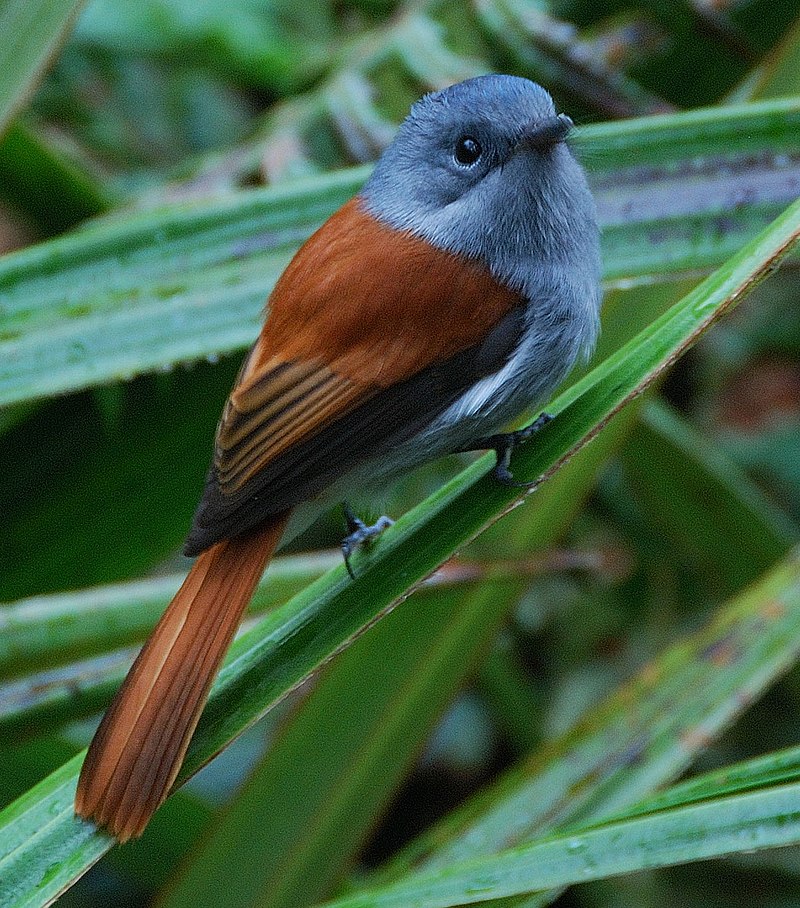
The Monarch flycatcher is a small passerine bird, belonging to the family Monarchidae. It inhabits forest or woodland areas across sub-Saharan Africa, south-east Asia, Australasia and various Pacific islands.
Only some species migrate seasonally. This beautiful little bird has a long tail and feeds mainly on insects it catches in its beak.
Its cup shaped nest can often be found hanging from branches high up in trees where they are safe from predators while incubating their eggs – usually between two to four of them at once.
The adult birds have attractive plumage with hues of blues and greens along with white patches near their tails which make for stunning displays when they take flight during mating season or migratory times.Scientific classification:
| Kingdom | Animalia |
| Phylum | Chordata |
| Class | Aves |
| Order | Passeriformes |
| Superfamily | Corvoidea |
| Family | Monarchidae Bonaparte, 1854 |
22. Trogon
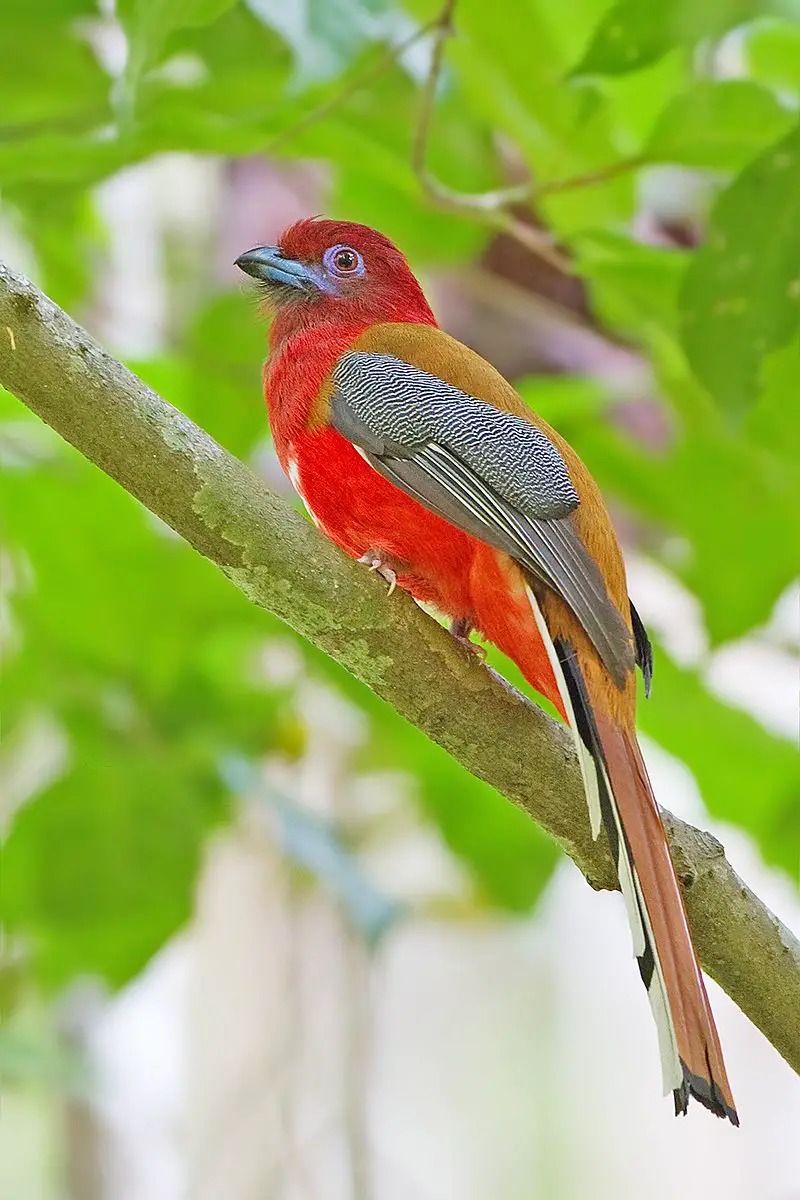
Trogons are a unique bird species that can be found all over the world. They belong to the order Trogoniformes and have only one family, called Trogonidae, which consists of 46 species in seven genera.
Fossil records show that trogons existed 49 million years ago during the Early Eocene period. It is believed they may be closely related or form part of two other orders: Coraciiformes and Passerines.
These birds typically have brightly colored feathers with some having iridescent colors on their wings and tails as well as red bellies and breasts.
Their diet mainly consists of fruit, insects, lizards and frogs but larger ones will also feed on small mammals such as mice or bats.
The most famous member from this group is Quetzalcoatlus – an extinct giant pterosaur which lived approximately 70-65 million years agoScientific classification:
| Kingdom | Animalia |
| Phylum | Chordata |
| Class | Aves |
| Clade | Cavitaves |
| Clade | Eucavitaves |
| Order | Trogoniformes AOU, 1886 |
| Family | Trogonidae Lesson, 1828 |
23. Sentinel Rock Thrush
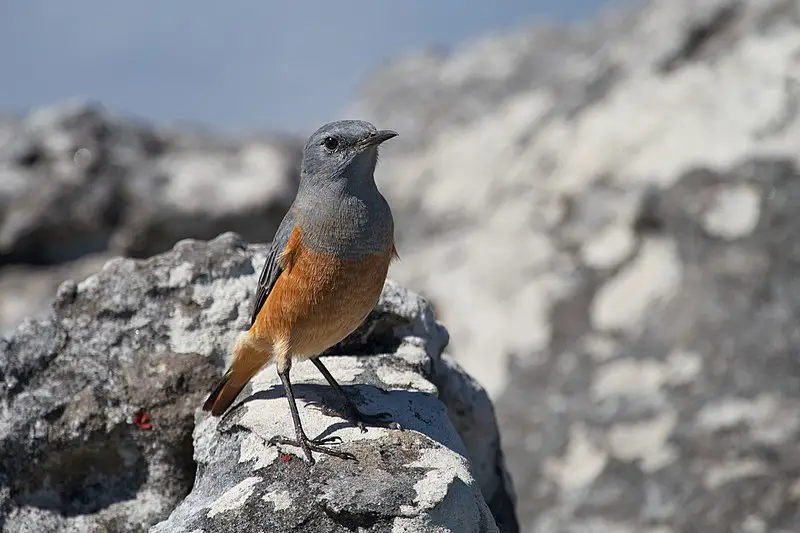
The sentinel rock thrush is a species of bird found in Lesotho, South Africa and Swaziland.
It resides mainly in high-altitude grassland habitats where it feeds on insects and other small invertebrates.
Its plumage consists of shades of grey and brown with some reddish highlights along its wings and tail feathers.
As part of the Muscicapidae family, these birds also have distinctive white patches around their eyes.
Sentinel rock thrushes are known to migrate during certain times throughout the year but they stay within their home range all year round while avoiding human disturbance as much as possible.
These birds make great avian indicators for conservationists due to their sensitivity towards changing environmental conditions; when a habitat becomes threatened or degraded, they will often be one of the first resident species to leave that location entirely.Scientific classification:
| Kingdom | Animalia |
| Phylum | Chordata |
| Class | Aves |
| Order | Passeriformes |
| Family | Muscicapidae |
| Genus | Monticola |
| Species | M. explorator |
Also Featured In: Johannesburg Birds You Need to Know,
24. Drakensberg Siskin
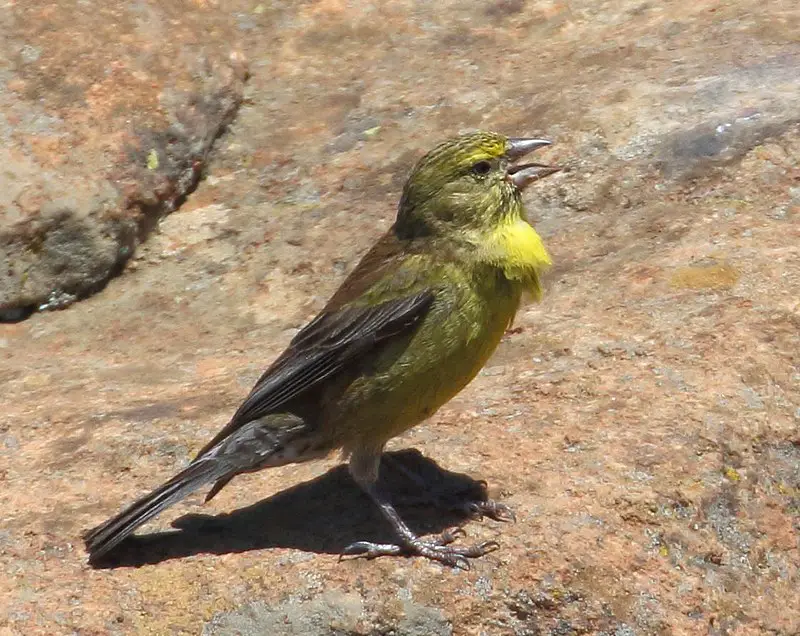
The Drakensberg siskin is a small passerine bird of the finch family, natively found in eastern Cape Province Transkei and western Natal in South Africa, as well as Lesotho.
It may potentially be conspecific with the Cape siskin from southern Cape Province if it is indeed true then C. t. totta would be its nominate form.
The adult birds have an overall dark green plumage which has yellowish edging on their wings and tail feathers while they also possess a black crown along with orange cheeks and breast patches.
These birds mainly feed on seeds but are known to occasionally consume insects too; they often forage together forming large flocks when doing so.
They breed during spring or summer laying clutches of up to 4 eggs at one time before incubating them for about two weeks post-laying period until hatching occurs eventually leading into fledglings after another few weeks’ stintScientific classification:
| Kingdom | Animalia |
| Phylum | Chordata |
| Class | Aves |
| Order | Passeriformes |
| Family | Fringillidae |
| Subfamily | Carduelinae |
| Genus | Crithagra |
| Species | C. symonsi |
25. African Red-Eyed Bulbul
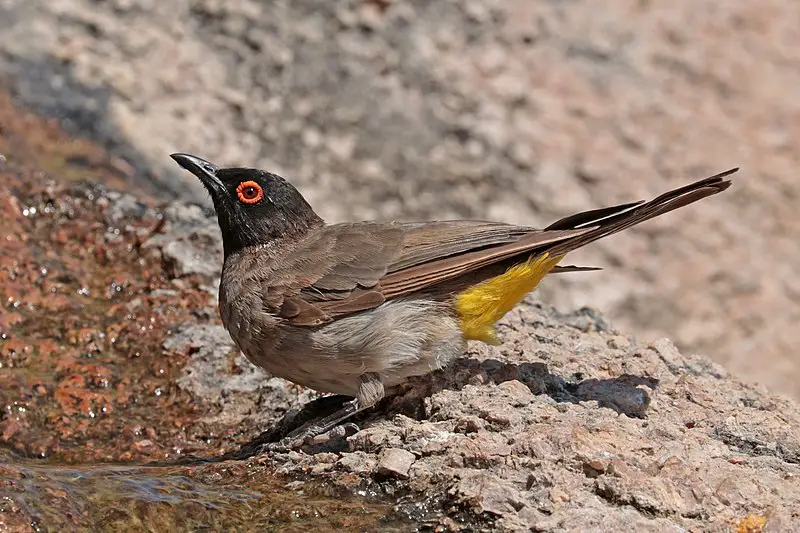
The African red-eyed bulbul is a species of songbird found in south-western Africa. It has black feathers on its front and reddish-brown plumage across the rest of its body, giving it an eye catching appearance.
The bird feeds mainly off fruit, flowers, nectar and insects which makes them omnivorous creatures that are easy to spot around their natural habitats such as dry savannas, subtropical or tropical dry shrubland and riverine scrublands.
They have an average length between 19 – 21 centimeters making them relatively small birds compared to some other species in the Pycnonotidae family but they make up for this with their strong vocal abilities.
Their distinct call can be heard from far distances which adds greatly to the charm of these beautiful birds.Scientific classification:
| Kingdom | Animalia |
| Phylum | Chordata |
| Class | Aves |
| Order | Passeriformes |
| Family | Pycnonotidae |
| Genus | Pycnonotus |
| Species | P. nigricans |
Also Featured In: Birds of Etosha National Park,
26. Three-Banded Plover
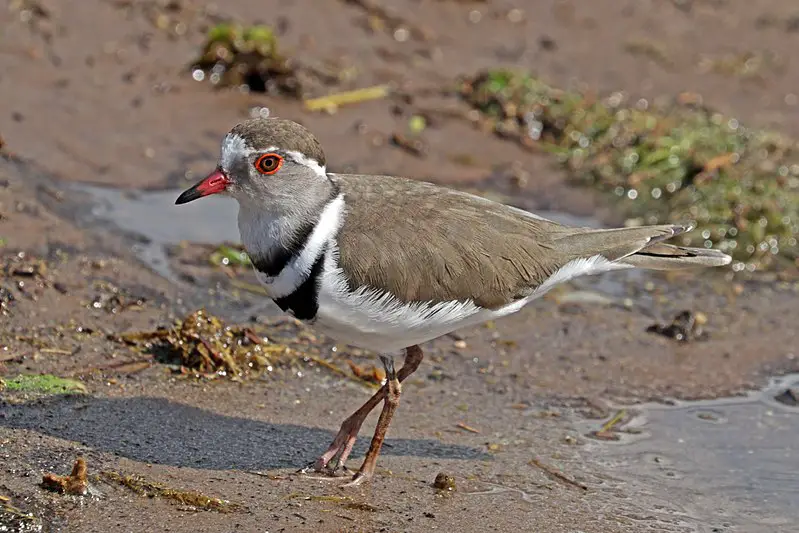
The Three-banded Plover is a small wader bird native to East Africa, southern Africa and Madagascar.
It has a distinct three-coloured banding of white, brown and black on its chest which sets it apart from other plovers.
This species prefers habitats such as inland rivers, pools and lakes but will also frequent exposed shores of the sea.
They hunt by sight for insects or crustaceans in shallow waters making them useful pest controllers in their environment.
The birds are mostly solitary but can form flocks when looking for food or breeding grounds during certain seasons.
These plovers make an attractive addition to any wetland habitat due to their vibrant colouration.Scientific classification:
| Kingdom | Animalia |
| Phylum | Chordata |
| Class | Aves |
| Order | Charadriiformes |
| Family | Charadriidae |
| Genus | Charadrius |
| Species | C. tricollaris |
27. Banded Martin
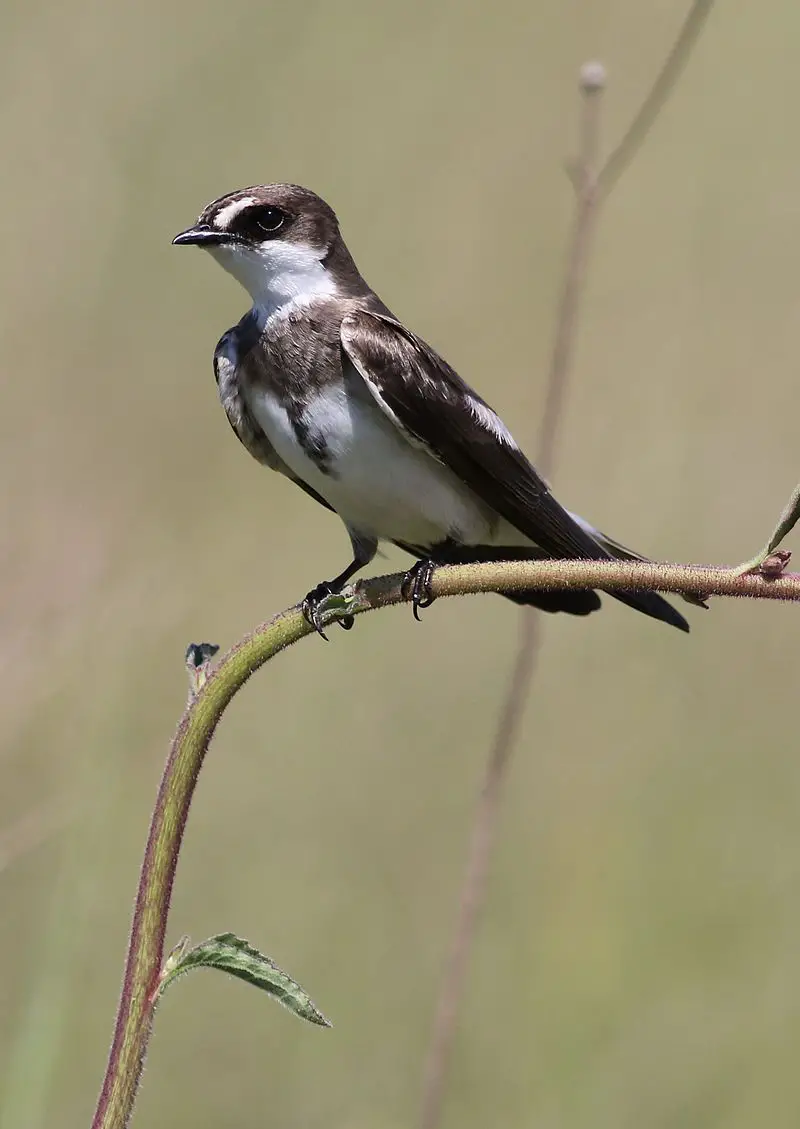
The Banded Martin is a small passerine bird that’s endemic to Africa and the only species of its genus Neophedina.
It was first described by French polymath Georges-Louis Leclerc in 1780 from a specimen collected at Cape of Good Hope.
This migratory bird has brownish upperparts, white throat with black stripes, grey underparts and tail feathers which are dark grey on top and pale underneath.
These birds feed mainly on flying insects like termites during flight, or sometimes they may catch prey while hovering over water surfaces before diving in for their food.
They can be seen near lakes or rivers where these birds breed in colonies between August – September making mud nests close to each other inside reeds beds or beneath rocks.Scientific classification:
| Kingdom | Animalia |
| Phylum | Chordata |
| Class | Aves |
| Order | Passeriformes |
| Family | Hirundinidae |
| Genus | Neophedina Roberts, 1922 |
| Species | N. cincta |
28. African Rock Pipit
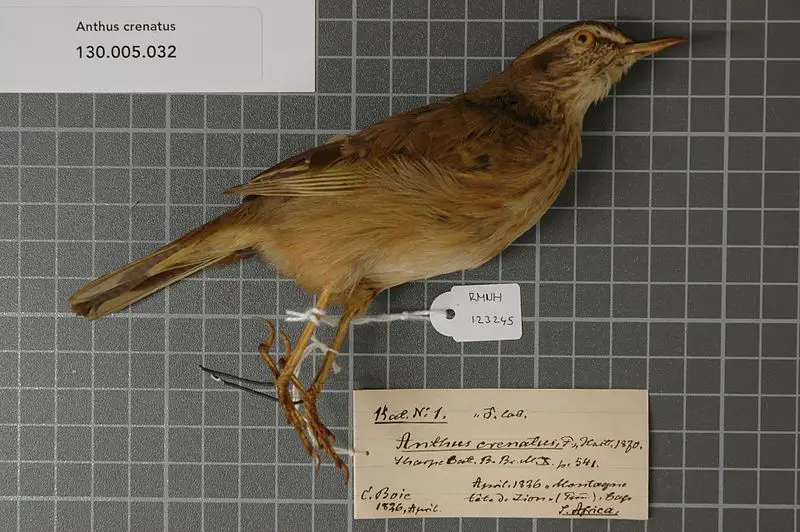
The African rock pipit is an attractive bird found mainly in South Africa and Lesotho.
It has a compact body shape that is uniformly brown with yellow-green edging on its wing coverts.
This species belongs to the family Motacillidae and forms a superspecies with the striped pipit.
These birds are typically seen inhabiting high-altitude, rocky grasslands where they forage for insects among low vegetation or on bare ground patches.
They have also been known to feed from ant swarms along roadsides when good opportunities present themselves.
The African rock pipit often perches atop rocks as well, adding to their picturesque charm while providing them additional protection against predators.Scientific classification:
| Kingdom | Animalia |
| Phylum | Chordata |
| Class | Aves |
| Order | Passeriformes |
| Family | Motacillidae |
| Genus | Anthus |
| Species | A. crenatus |
29. Bokmakierie
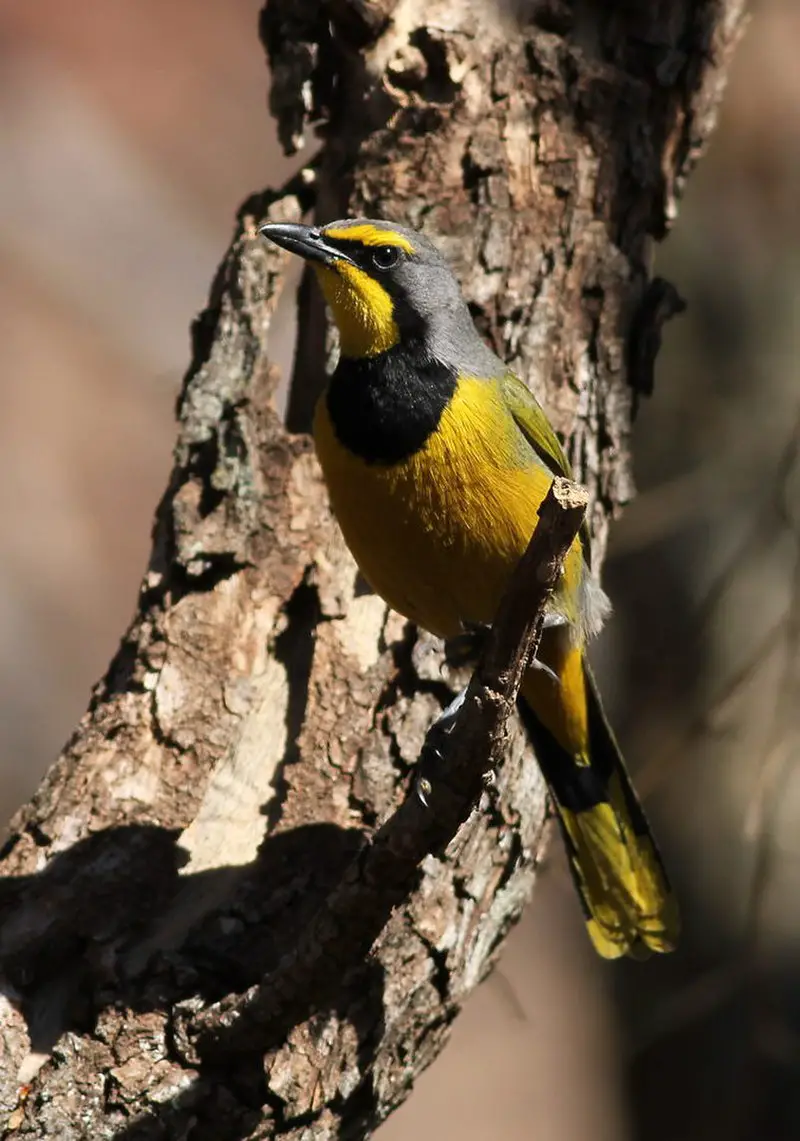
The Bokmakierie is a species of bushshrike native to southern Africa. It can be found mainly in South Africa and Namibia, with an isolated population located in the mountains between Zimbabwe and Mozambique.
This bird prefers open habitats such as grasslands or savannas but also sometimes inhabits scrubby areas.
It has grey-brown upperparts with white underparts, yellow eyes and black wings that are tipped with white spots.
The most distinctive feature of this species is its loud call which typically consists of two syllables – “bok” followed by “maa-kieee” – hence its name.
They often form pairs or small family groups when foraging for food such as insects, spiders, lizards and other small invertebrates on the ground or low shrubs.Scientific classification:
| Kingdom | Animalia |
| Phylum | Chordata |
| Class | Aves |
| Order | Passeriformes |
| Family | Malaconotidae |
| Genus | Telophorus |
| Species | T. zeylonus |
30. Lybiidae
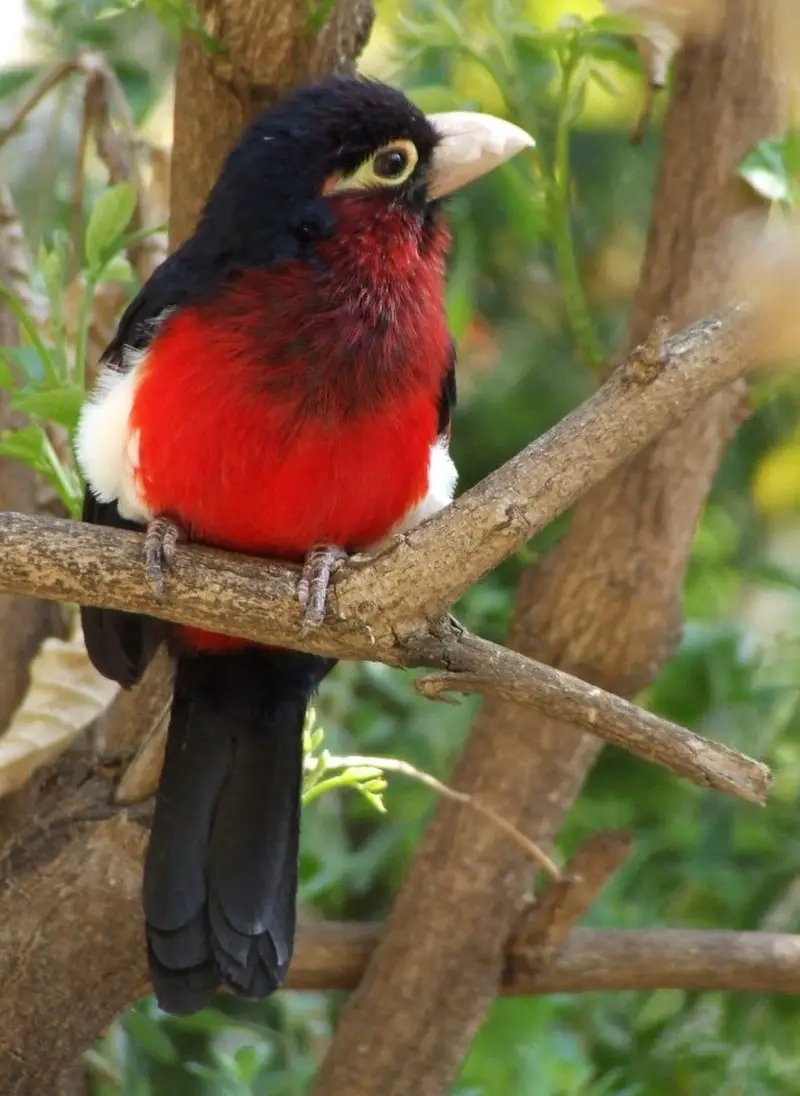
African barbets, belonging to the family Lybiidae, are a large group of birds found throughout sub-Saharan Africa.
They come in different sizes and inhabit various habitats from forests interiors to scrublands.
The Trachyphoninae species live mainly in the southern Sahara desert up until South Africa.
These colourful birds have distinctive features such as their short neck and stout bill that is used for cracking open hard nuts or drilling into tree bark for food.
Some African barbet species are important pollinators of flowers due to their diet consisting mostly on fruits and nectar which forces them to visit many plants daily.
Their bright calls can be heard throughout the day making them easily recognisable by humans too.Scientific classification:
| Kingdom | Animalia |
| Phylum | Chordata |
| Class | Aves |
| Order | Piciformes |
| Infraorder | Ramphastides |
| Family | Lybiidae Sibley & Ahlquist, 1985 |
31. Mountain Pipit
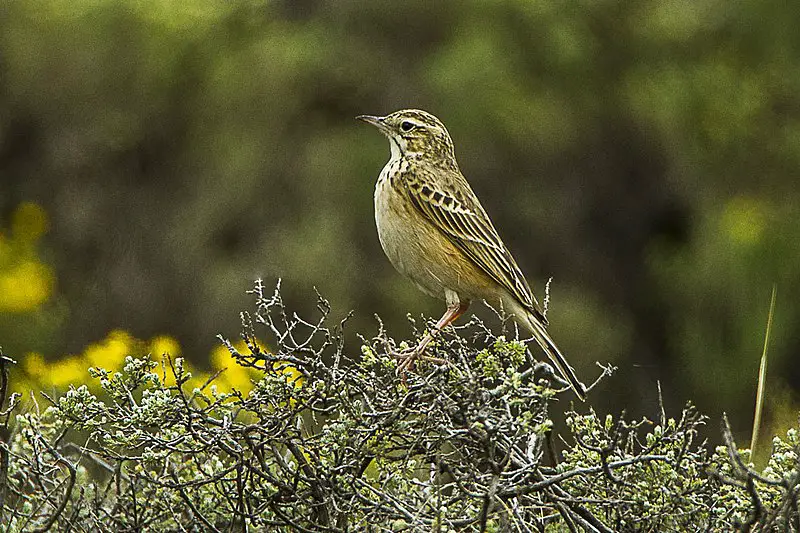
The Mountain pipit is a species of bird belonging to the family Motacillidae.
It lives in high-altitude grassland regions, such as Lesotho, South Africa and possibly Botswana, Democratic Republic of Congo, Namibia or Zambia.
Its plumage consists mainly of greyish brown with white on its lower chest and throat area; it also has faint streaks along its back that are usually not visible from far away.
As an omnivore diet consists mainly insects but may include other invertebrates or small fruits depending on seasonality.
The Mountain Pipit needs large open areas for breeding and foraging so their populations can be very sensitive to habitat destruction like any other animal species living in similar habitats.Scientific classification:
| Kingdom | Animalia |
| Phylum | Chordata |
| Class | Aves |
| Order | Passeriformes |
| Family | Motacillidae |
| Genus | Anthus |
| Species | A. hoeschi |
32. Greater Honeyguide
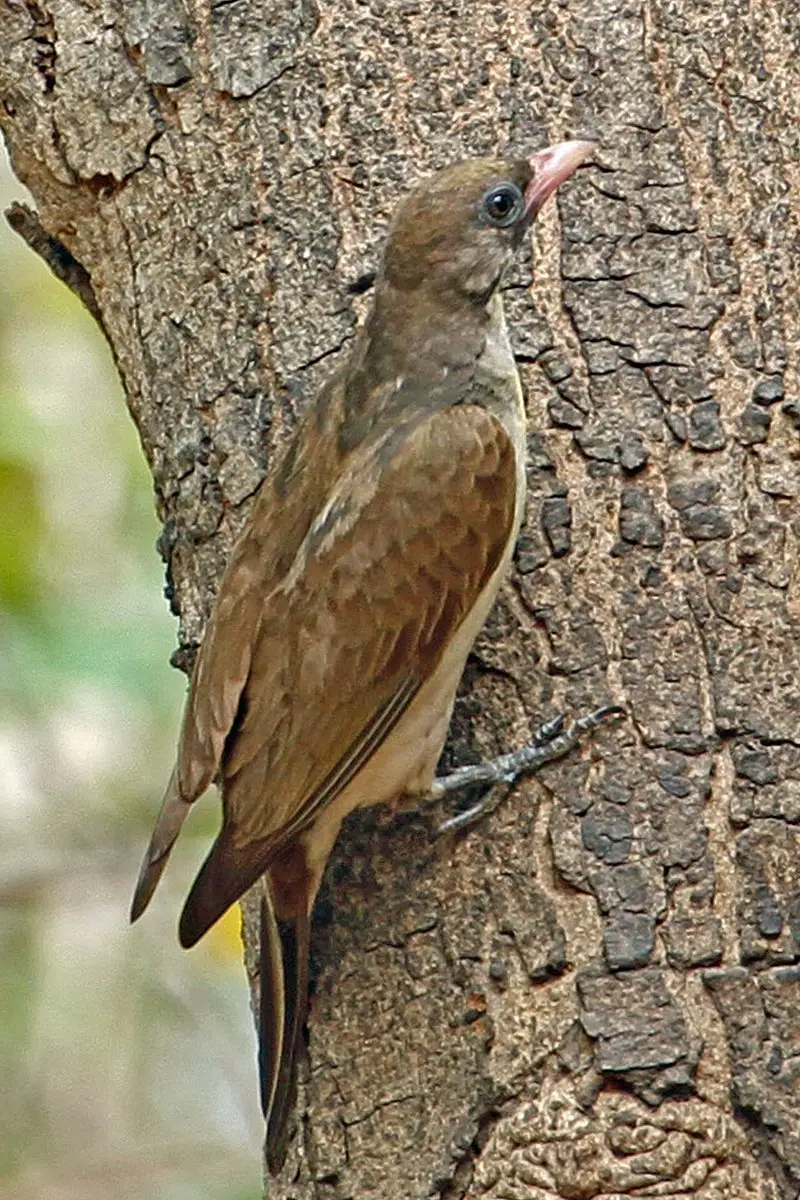
The Greater Honeyguide Bird is a species of bird native to sub-Saharan Africa. It belongs to the family Indicatoridae and is related to woodpeckers.
Its name comes from its behavior of guiding humans or other animals towards bee colonies, though this claim has been disputed.
This bird can be found in various habitats such as forests, savannahs, and bushlands where it feeds on beeswax and larvae after leading others there.
They are monogamous birds that build their nests together out of twigs lined with plant fibers or hair near human settlements like farms or villages for protection against predators.
The female lays two eggs at once which hatch within 12 days before fledging another 17 days afterwards.
These birds play an important role in ecology by helping spread pollen between plants while they search for food sources.Scientific classification:
| Kingdom | Animalia |
| Phylum | Chordata |
| Class | Aves |
| Order | Piciformes |
| Family | Indicatoridae |
| Genus | Indicator |
| Species | I. indicator |
33. Speckled Pigeon
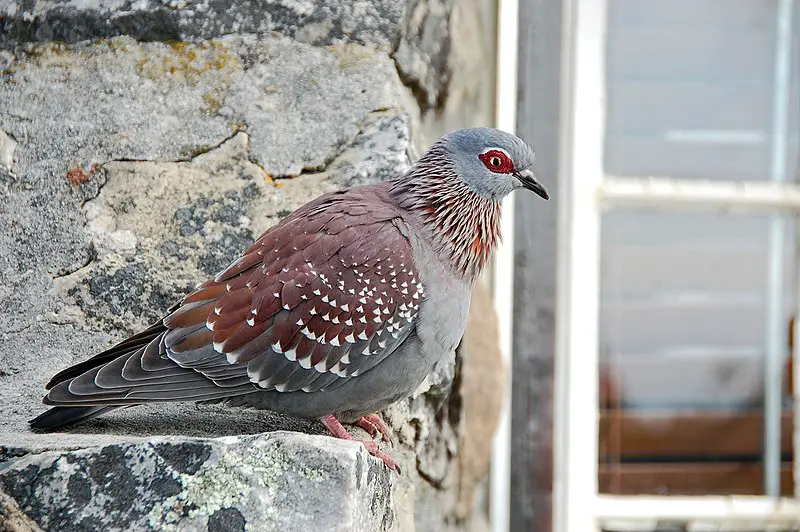
The Speckled Pigeon, also known as the African Rock Pigeon or Guinea pigeon due to its similar coloring to some species of guineafowl, is a resident breeding bird in much of Africa south of the Sahara.
It’s commonly seen inhabiting open habitats and has been around since 1747 when it was first described by Swedish naturalist Carl Linnaeus.
These birds usually have grey bodies with speckles on their wings, although they can vary from brownish-grey to dark slate blue depending on where they’re found geographically.
They feed mostly on seeds and other grain crops but will sometimes supplement that diet with insects if available.
In general these pigeons are harmless unless threatened – so be sure not to startle them.Scientific classification:
| Kingdom | Animalia |
| Phylum | Chordata |
| Class | Aves |
| Order | Columbiformes |
| Family | Columbidae |
| Genus | Columba |
| Species | C. guinea |
34. Cape Starling
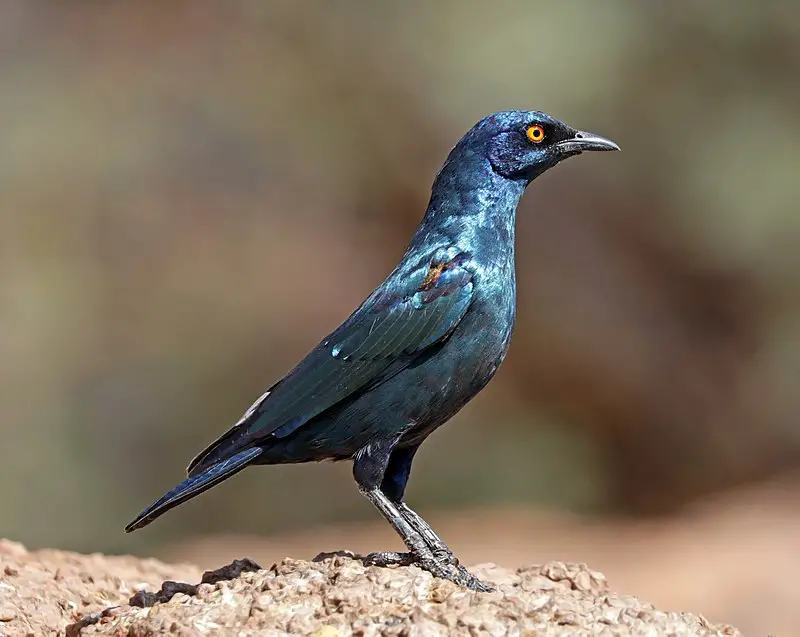
The Cape starling is a species of starling native to Southern Africa, living in woodlands, bushveld and even suburbs. It has two subspecies; the larger ‘L. n. culminator’ having greener wings and tail plumage than its counterpart.
These birds are mainly grey in colour with white spots on their bodies and bright red eyes which make them stand out from other similar-looking species found in the region.
They have long bills for picking up food items such as insects, seeds or berries along with powerful legs for perching upon trees or wires alike – an important trait when it comes to finding shelter during bad weather.
The males also have glossy black heads while females possess pale brown ones; both sexes share common yellow beaks making this bird a beautiful sight indeed.Scientific classification:
| Kingdom | Animalia |
| Phylum | Chordata |
| Class | Aves |
| Order | Passeriformes |
| Family | Sturnidae |
| Genus | Lamprotornis |
| Species | L. nitens |
Also Featured In: Birds that You’ll Find in Kruger national park,
35. Northern Black Korhaan
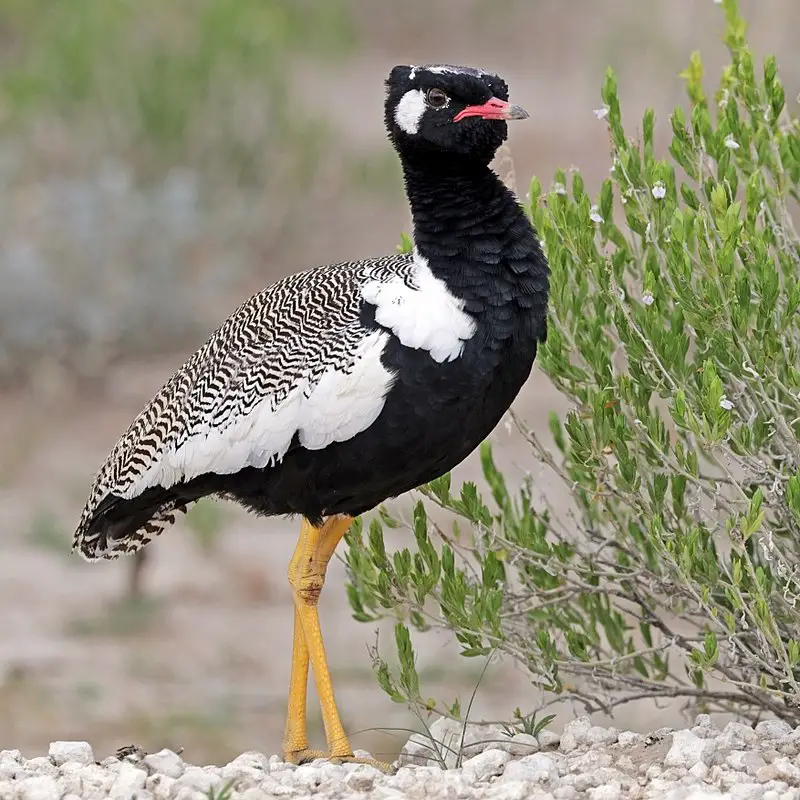
The Northern Black Korhaan, or White-Quilled Bustard, is an impressive bird found across Southern Africa. This species of bustard is highly adapted to open grasslands and scrubland habitats.
It was first discovered by Andrew Smith in 1831 and given the scientific name “afrao”.
The appearance of these birds can vary greatly depending on where they are located; some feature a distinctive white head plume while others have black feathers that cover their whole bodies.
They also tend to be quite large with wingspans reaching up to 42 inches long. These majestic creatures play important roles in their ecosystems as both predators and prey for other animals.
Despite all this beauty, sadly populations have been declining due to human activities such as habitat destruction and hunting pressure from poachers.
With conservation efforts we hope that the future looks brighter for these amazing birds.Scientific classification:
| Kingdom | Animalia |
| Phylum | Chordata |
| Class | Aves |
| Order | Otidiformes |
| Family | Otididae |
| Genus | Afrotis |
| Species | A. afraoides |
36. Blue Korhaan
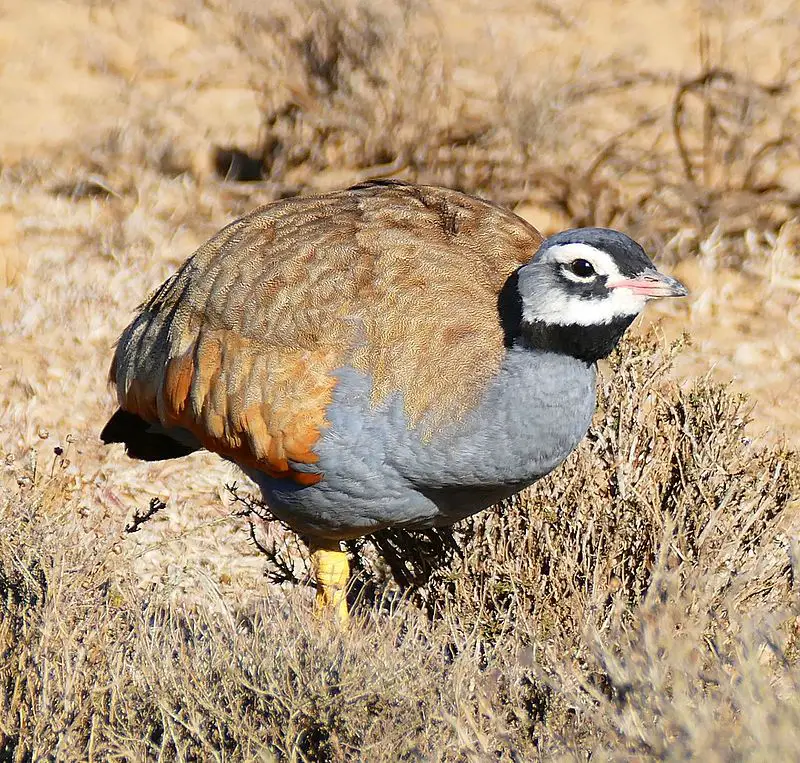
The Blue Korhaan is a species of bird found in South Africa, belonging to the family Otididae. It has blue plumage and its call consists of frog-like croaks which are often uttered while flying.
Its habitat includes plateau grasslands, dry shrublands, arable land and pastureland. They prefer habitats with short grasses and flat terrain as they are ground-dwellers by nature.
These birds can be seen foraging on the ground or perched on low branches during their search for food such as insects, small lizards or fruits scattered across the landscape.
The endangered status of this species means that conservation efforts must be undertaken if we want it to survive into future generations.Scientific classification:
| Kingdom | Animalia |
| Phylum | Chordata |
| Class | Aves |
| Order | Otidiformes |
| Family | Otididae |
| Genus | Eupodotis |
| Species | E. caerulescens |
37. Black-Collared Barbet
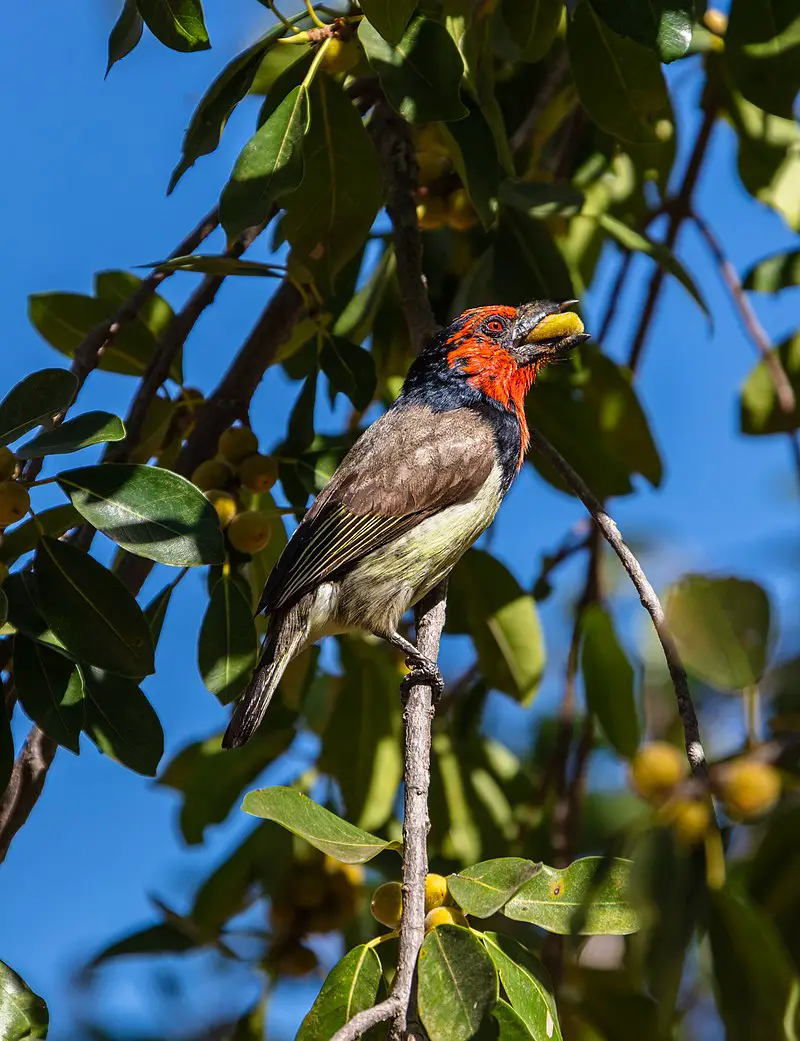
The Black-collared barbet is a species of bird found in sub-Saharan Africa. Indigenous peoples have various names for this brightly coloured creature, such as Rooikophoutkapper in Afrikaans, IsiKhulukhulu and IsiQonQotho in Zulu, and Isinagogo in Xhosa.
It can be seen across Angola, Botswana, Burundi, Democratic Republic of the Congo (DRC), Eswatini (formerly Swaziland), Kenya, Lesotho Malawi and Mozambique.
This medium sized bird has mainly black feathers with white speckles on its wings. The most distinctive feature is its bright yellow collar around its neck which gives it an attractive appearance.
These birds are often observed feeding on fruits or insects from trees or shrubs making them entertaining to watch for any wildlife enthusiast.Scientific classification:
| Kingdom | Animalia |
| Phylum | Chordata |
| Class | Aves |
| Order | Piciformes |
| Family | Lybiidae |
| Genus | Lybius |
| Species | L. torquatus |
38. Greater Kestrel
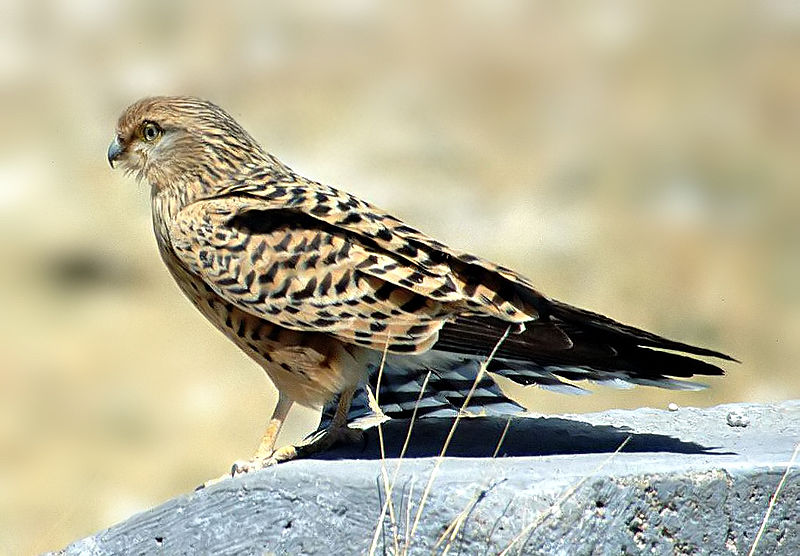
The Greater Kestrel, a large bird of prey from the Falconidae family, is found in open country throughout southern and eastern Africa.
It has mainly pale rufous plumage above and below with black barring on its back, upperwing and flanks.
Its breast has dark streaks while its head is streaked buff-brown with white eyes – hence it’s name; White-eyed Kestrel.
These birds are primarily carnivorous eating small mammals such as rodents, lizards or insects which they catch either by hovering high up or perched atop tall trees.
They also take advantage of human settlements to supplement their diet when food becomes scarce during harsher seasons.
Historically these birds were used for falconry but now they are increasingly threatened due to habitat loss caused by humans across their range making conservation efforts all the more important if we wish to ensure this majestic species will continue flying our skies for generations to come.Scientific classification:
| Kingdom | Animalia |
| Phylum | Chordata |
| Class | Aves |
| Order | Falconiformes |
| Family | Falconidae |
| Genus | Falco |
| Species | F. rupicoloides |
39. Diederik Cuckoo
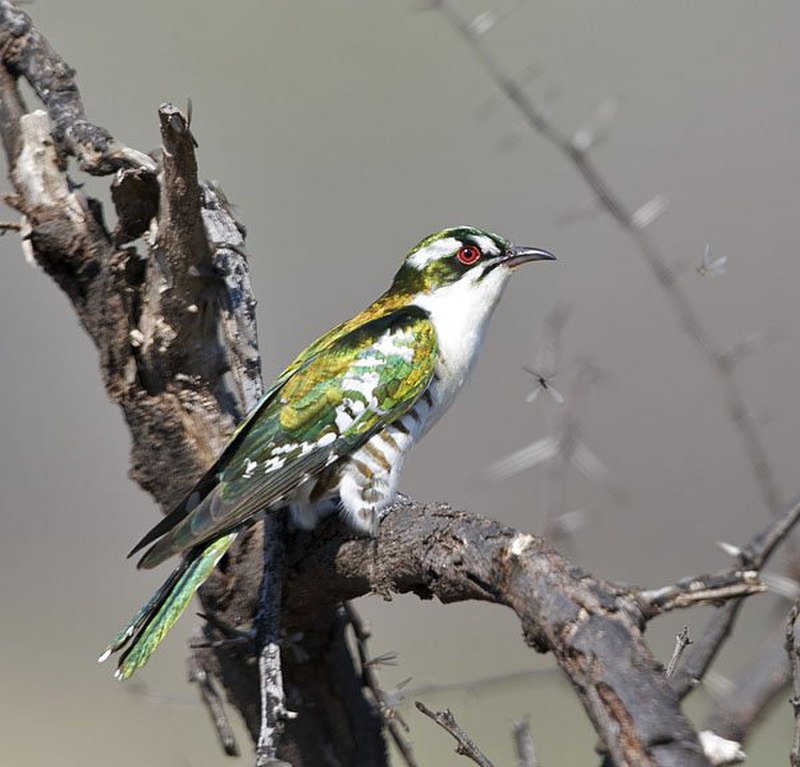
The Diederik Cuckoo is a small and beautiful bird native to the Cape of Good Hope region in South Africa. It has an attractive plumage with black, white and grey feathers covering its body.
Its flight is agile as it soars through the air gracefully on long wings.
The species gets its name from Dutch colonialist Jan van Riebeeck who named it after his friend Diederik Westerwoltz when they encountered one together in 1662 near Table Bay.
This cuckoo prefers open woodlands where they can find their preferred food items like grasshoppers, crickets and caterpillars among others.
They are also known for laying eggs in other birds’ nests which leads to them being adopted by these unsuspecting hosts unknowingly.Scientific classification:
| Kingdom | Animalia |
| Phylum | Chordata |
| Class | Aves |
| Order | Cuculiformes |
| Family | Cuculidae |
| Genus | Chrysococcyx |
| Species | C. caprius |
40. Red-Billed Teal
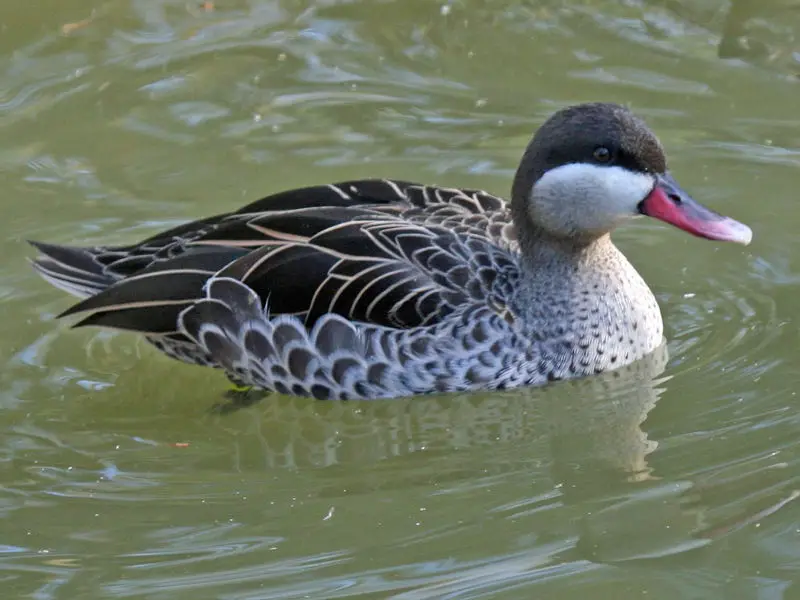
The red-billed teal is a dabbling duck native to southern and eastern Africa. It boasts an impressive abundance as a resident breeder in these regions, often found south of 10° S.
This species is not migratory yet it has been observed flying long distances to find suitable waters for living.
Outside the breeding season they tend to congregate around each other forming large flocks that are easy to identify due their striking plumage consisting mainly of reddish bills and gray bodies with black speckles on top accompanied by white patches near its wings and at the base of its neck area.
The German naturalist Johann Friedrich Gmelin first described this bird back in 1789 giving us insight into what we know today about them.Scientific classification:
| Kingdom | Animalia |
| Phylum | Chordata |
| Class | Aves |
| Order | Anseriformes |
| Family | Anatidae |
| Genus | Anas |
| Species | A. erythrorhyncha |
41. Yellow-Breasted Pipit
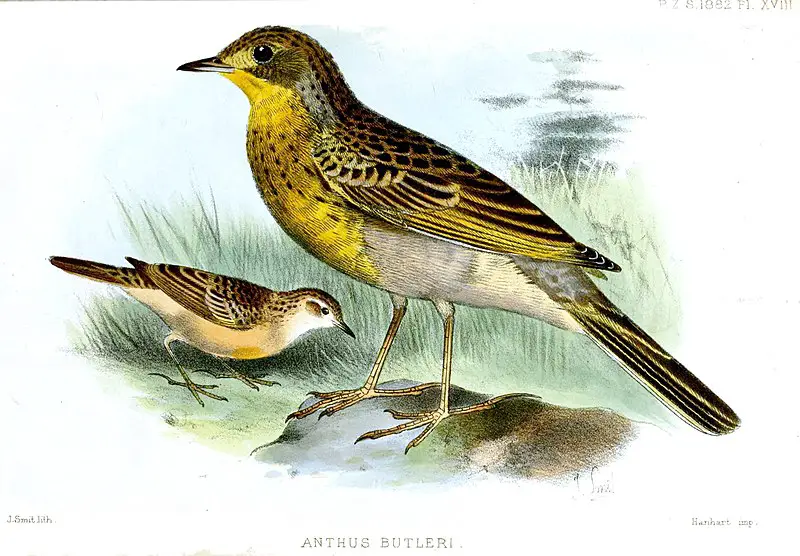
The Yellow-breasted Pipit is a species of bird found in Lesotho and South Africa. It has yellow breast feathers that contrast against its light brown back, making it easily identifiable.
The pipit usually lives in high altitude grasslands, arable land or pastureland but they are increasingly becoming more threatened due to loss of habitat.
These birds have fascinating habits such as raising their wings when singing which gives them an impressive silhouette while perched on a branch.
They also tend to make frequent hops along the ground looking for food items like insects and seeds.
Conservation efforts must be taken if this beautiful species is going survive into future generations so we can continue to enjoy their presence.Scientific classification:
| Kingdom | Animalia |
| Phylum | Chordata |
| Class | Aves |
| Order | Passeriformes |
| Family | Motacillidae |
| Genus | Anthus |
| Species | A. chloris |
42. Yellow Bishop
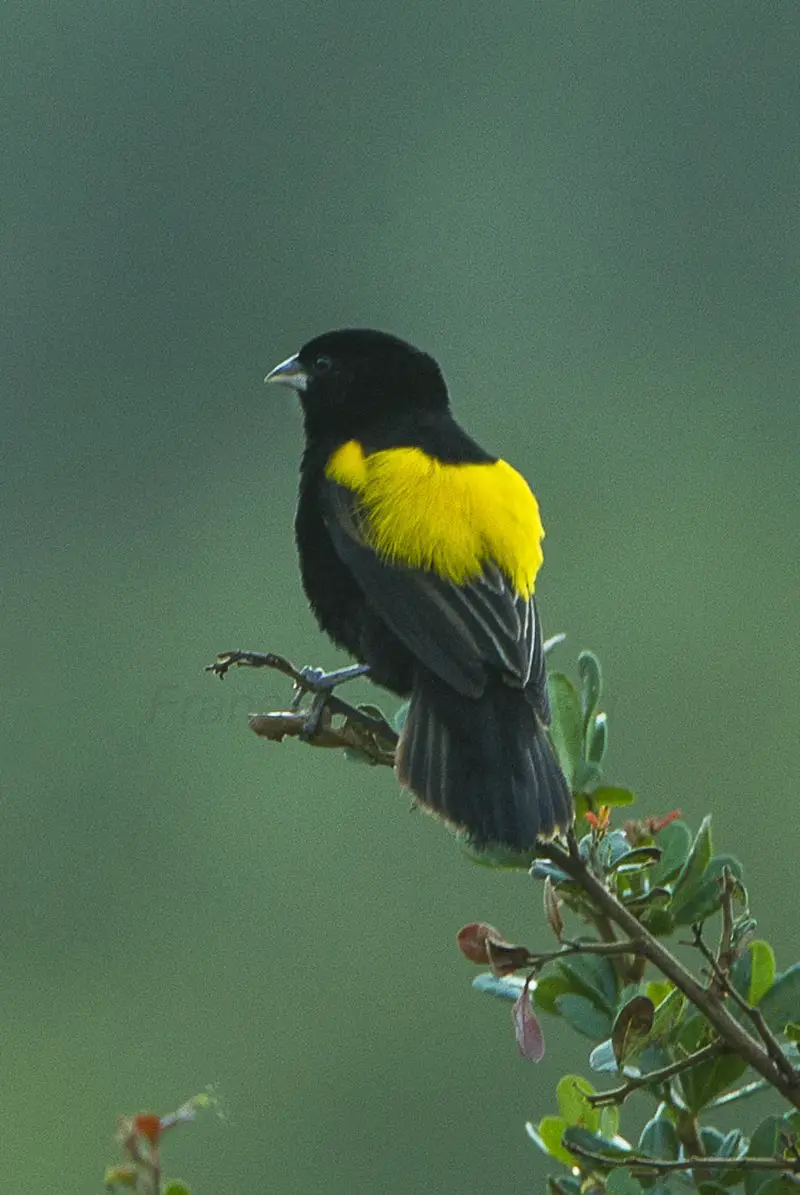
The Yellow Bishop is a stunningly vibrant bird, native to regions of Africa such as Angola, Botswana and Tanzania. It has yellow plumage on its head, back and wings, with a contrasting black tail and belly.
Its most distinctive feature are the bright orange-yellow patches which adorn its rump area – hence one of its many names ‘Yellow Rumped Widow’.
This small bird prefers open savanna or grassland habitats where it can nest in trees near water sources.
Interestingly enough they even build their nests using spider webs as an adhesive to hold together bark strips.
The Yellow Bishop is quite common across much of Sub Saharan Africa but conservation efforts will be needed so that we may continue appreciating these beautiful birds for years to comeScientific classification:
| Kingdom | Animalia |
| Phylum | Chordata |
| Class | Aves |
| Order | Passeriformes |
| Family | Ploceidae |
| Genus | Euplectes |
| Species | E. capensis |
43. Greater Double-Collared Sunbird
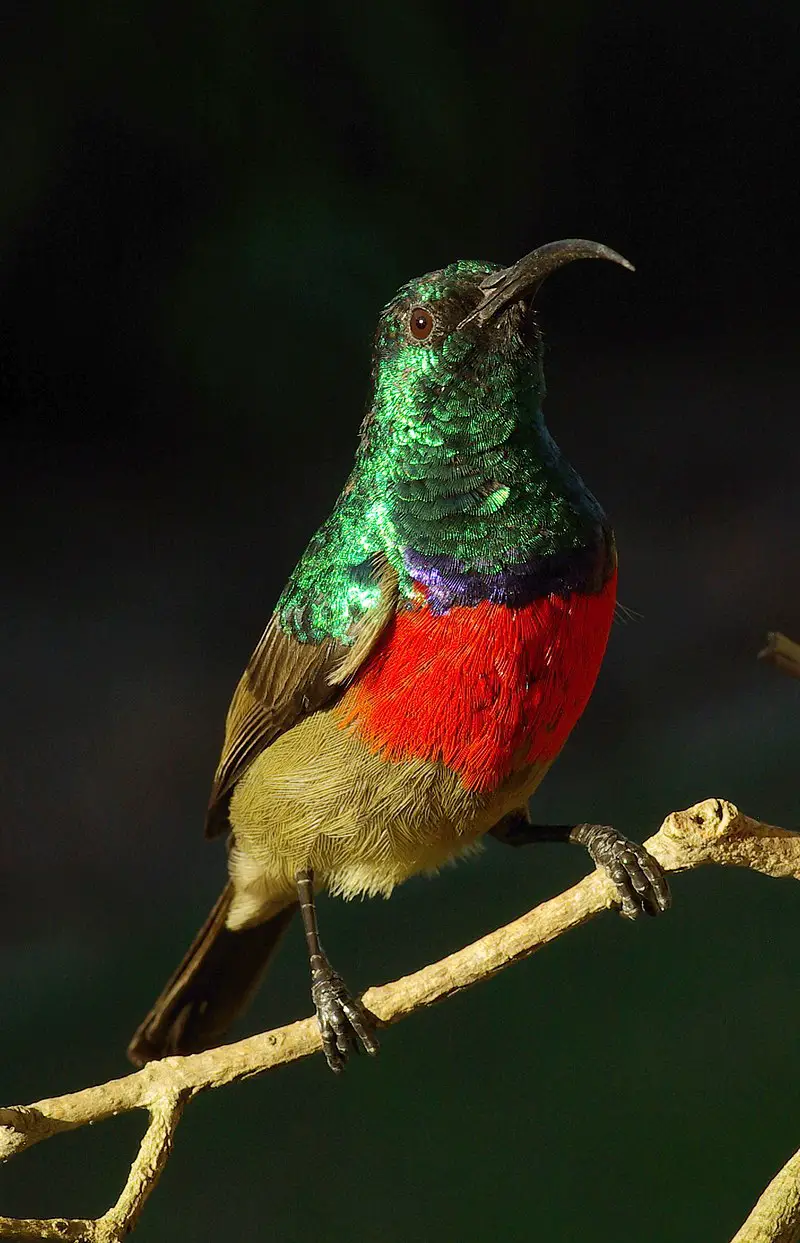
The Greater Double-Collared Sunbird is a small bird belonging to the sunbird family. It can be found in southern South Africa and its range includes gardens, fynbos, forest edges and coastal scrub.
The adult males measure 14 cm in length and have distinctive black upperparts with an orange throat patch that extends down onto their chest.
Females are duller overall but also have patches of yellow on their throats as well as some blue feathers around the eyes and wings.
This species feeds mainly on nectar from flowers or insects taken while hovering at flowers or catching them mid-air.
They may occasionally feed upon fruits or take water directly from streams when available during dry conditions.Scientific classification:
| Kingdom | Animalia |
| Phylum | Chordata |
| Class | Aves |
| Order | Passeriformes |
| Family | Nectariniidae |
| Genus | Cinnyris |
| Species | C. afer |
44. Large-Billed Lark
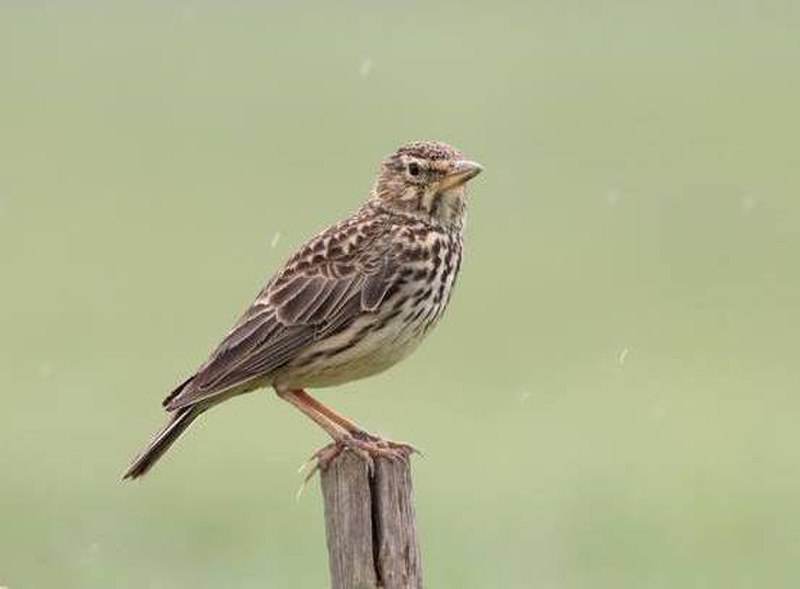
The Large-billed Lark is a small passerine bird found in southern Africa. It has a distinctive large bill, giving it its name.
Its plumage is mostly sandy brown with light streaks on the back and wings, as well as darker markings around its eyes.
The underside of this lark’s body consists of white feathers that are heavily streaked with blackish lines along their edges.
This species can be distinguished from other alaudids by its long tail and longer legs than most other larks in the region.
In addition to this, they have loud calls which consist of short notes followed by trills or rattles at times during flight display calls made when courting mates or defending territories against intruders.
These birds mainly feed on seeds but also consume insects if available in abundance near themScientific classification:
| Kingdom | Animalia |
| Phylum | Chordata |
| Class | Aves |
| Order | Passeriformes |
| Family | Alaudidae |
| Genus | Galerida |
| Species | G. magnirostris |
45. Grey-Winged Francolin
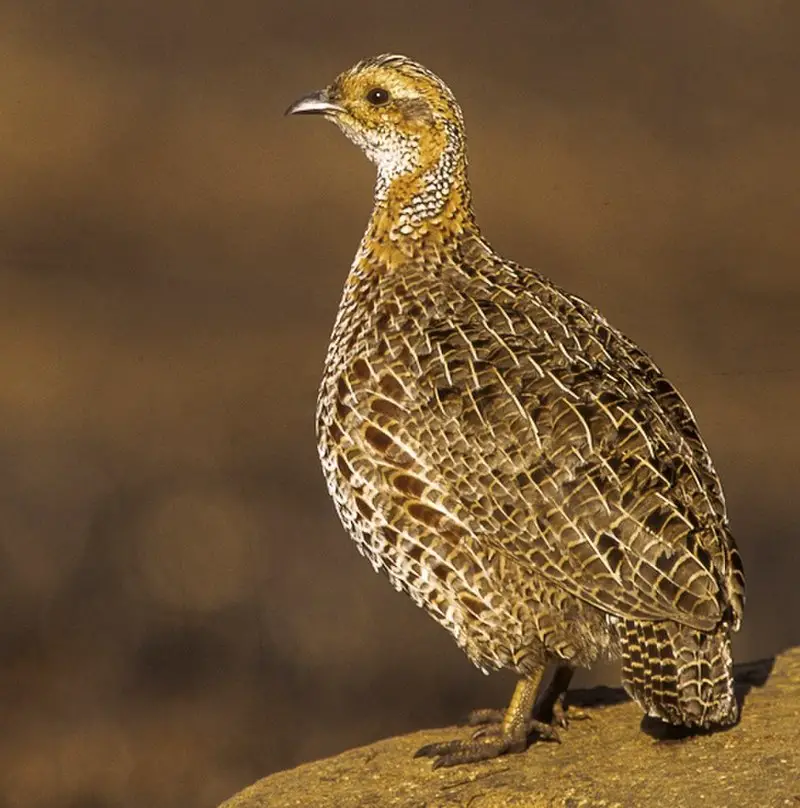
The Grey-winged Francolin is a species of bird belonging to the family Phasianidae. It can be found in Lesotho and South Africa, where it inhabits grassy areas near rivers or streams.
The francolin has grey wings with white spots on them, as well as black tail feathers and a red bill.
Its underparts are mostly dark brown and its head has black stripes running from eye to nape that blend into one another at the back of its neck for an impressive display.
This ground dwelling bird feeds mainly on insects, but will also eat seeds if available during lean times.
They form small flocks when feeding together before roosting high up in trees overnight to avoid predators like snakes or cats.
In general they prefer open spaces such as savannahs but may venture into more densely forested regions too – making them quite adaptable birds indeed.Scientific classification:
| Kingdom | Animalia |
| Phylum | Chordata |
| Class | Aves |
| Order | Galliformes |
| Family | Phasianidae |
| Genus | Scleroptila |
| Species | S. afra |
46. Southern Bald Ibis
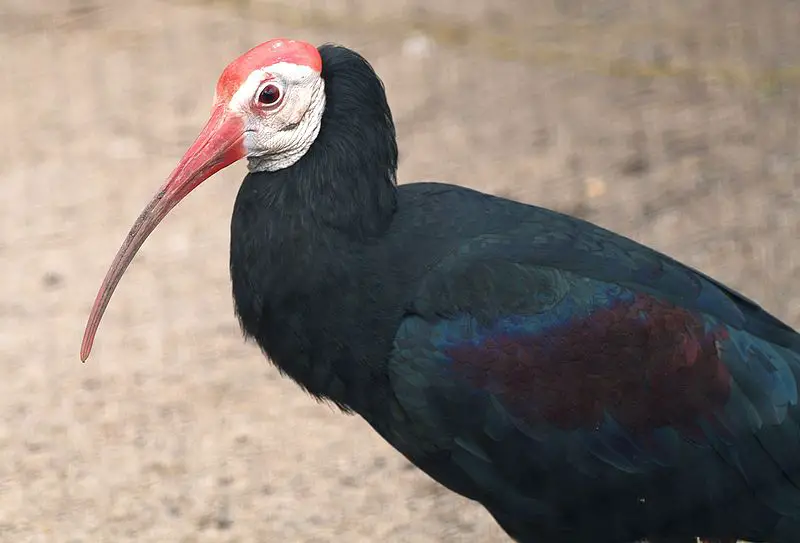
The Southern bald ibis is a large bird native to southern Africa. It can be found in open grasslands and semi-deserts, usually at high altitudes in the mountains.
Taxonomically, it is closely related to its counterpart from northern regions of Africa – the Waldrapp.
This species has an extremely limited homerange, being only present in South Africa’s southernmost areas.
The Southern Bald Ibis stands out due to its distinct black feathers with a greenish gloss on them and bright red skin around their eyes and bill area that contrasts beautifully against its white face.
They mainly feed on snakes, lizards insects or small birds as well as carrion when available..Scientific classification:
| Kingdom | Animalia |
| Phylum | Chordata |
| Class | Aves |
| Order | Pelecaniformes |
| Family | Threskiornithidae |
| Genus | Geronticus |
| Species | G. calvus |
47. Lesser Striped Swallow
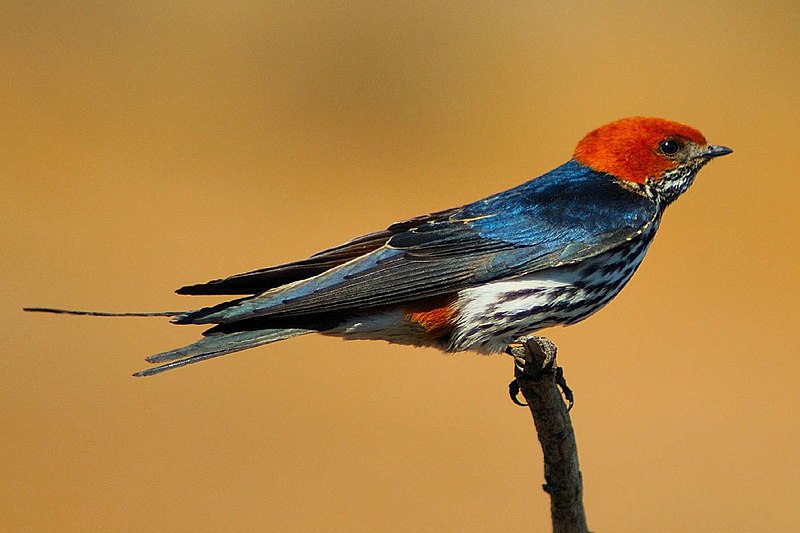
The lesser striped swallow is a large and beautiful bird native to Sub-Saharan Africa. It inhabits mainly lowland wooded areas, but some South African birds migrate further north in the winter months.
They have striking plumage of white undersides with black streaks on their wings and back as well as reddish brown chests.
The diet consists mostly of flying insects which they catch while flying over water or treetops.
Breeding season occurs during spring when pairs create mud nests under eaves or other sheltered sites near bodies of water.
Once hatched, both parents will take turns feeding the young until fledging at around 17 days old.Scientific classification:
| Kingdom | Animalia |
| Phylum | Chordata |
| Class | Aves |
| Order | Passeriformes |
| Family | Hirundinidae |
| Genus | Cecropis |
| Species | C. abyssinica |
48. Cape Longclaw
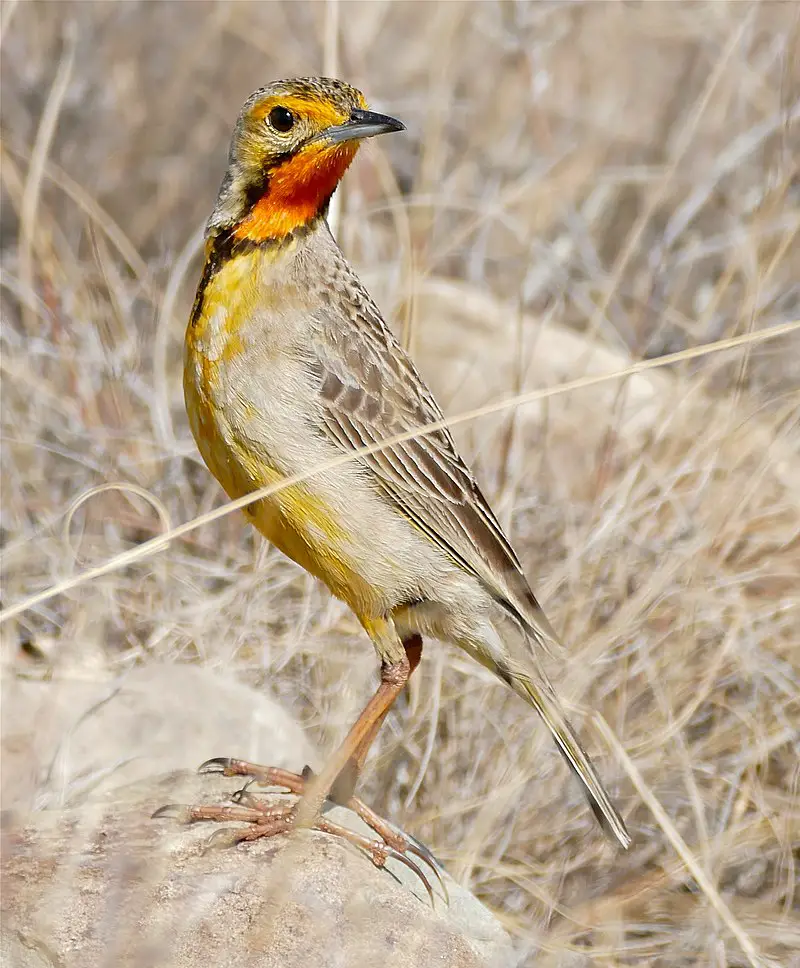
The Cape Longclaw is a beautiful bird native to Zimbabwe and southern and eastern South Africa. It has an orange throat, yellow breast and black head with white stripes that make it easily recognizable.
This species can be found in coastal or mountain grasslands near water sources like rivers or lakes.
First described by the French zoologist Mathurin Jacques Brisson in 1760, these birds feed on insects as well as seeds which they search for while walking along the ground looking for food items .
They are often seen perched atop of tall grasses surveying their surroundings before diving down to capture prey from the vegetation below them.
The Cape longclaw makes its nest out of dry plant material such as reeds which it builds at ground level among thickets of vegetation close enough so predators cannot reach them easily.Scientific classification:
| Kingdom | Animalia |
| Phylum | Chordata |
| Class | Aves |
| Order | Passeriformes |
| Family | Motacillidae |
| Genus | Macronyx |
| Species | M. capensis |
49. Promeropidae
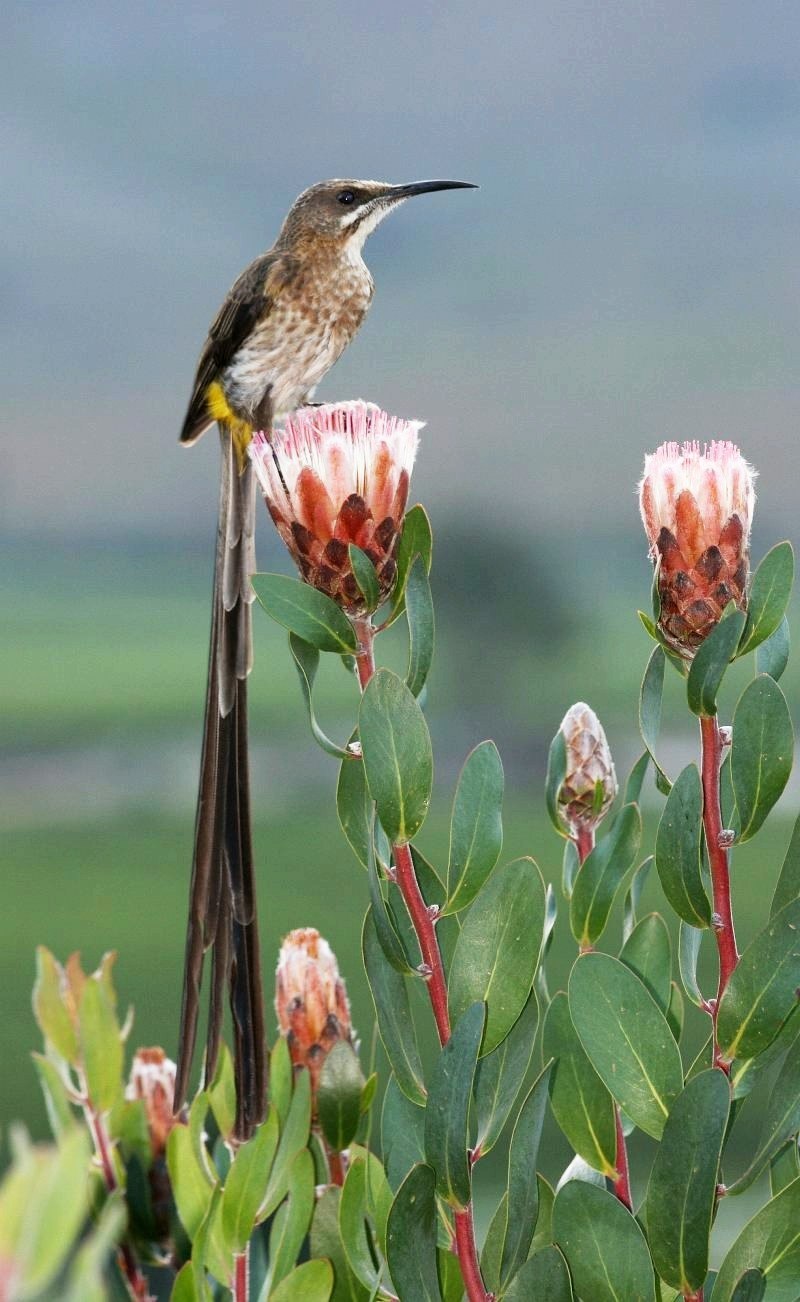
Promeropidae birds are a small family of passerine birds native to southern Africa, belonging to the genus Promerops.
They have brownish plumage with long tail feathers and a down-curved bill that is typical of most nectar feeders.
These birds share many similarities in appearance and habits with larger sunbirds, but may be more closely related to Australian honeyeaters.
They usually live solitary lives foraging for flowers or fruit from trees and shrubs as their main source of food, although they also catch insects on occasion.
In addition to being excellent pollinators due to their unique curved bills which allow them easier access into narrow flower openings than other species, these special little creatures often make delightful additions to any nearby garden.Scientific classification:
| Kingdom | Animalia |
| Phylum | Chordata |
| Class | Aves |
| Order | Passeriformes |
| Family | Promeropidae Vigors, 1825 |
| Genus | Promerops Brisson, 1760 |
50. Southern Double-Collared Sunbird
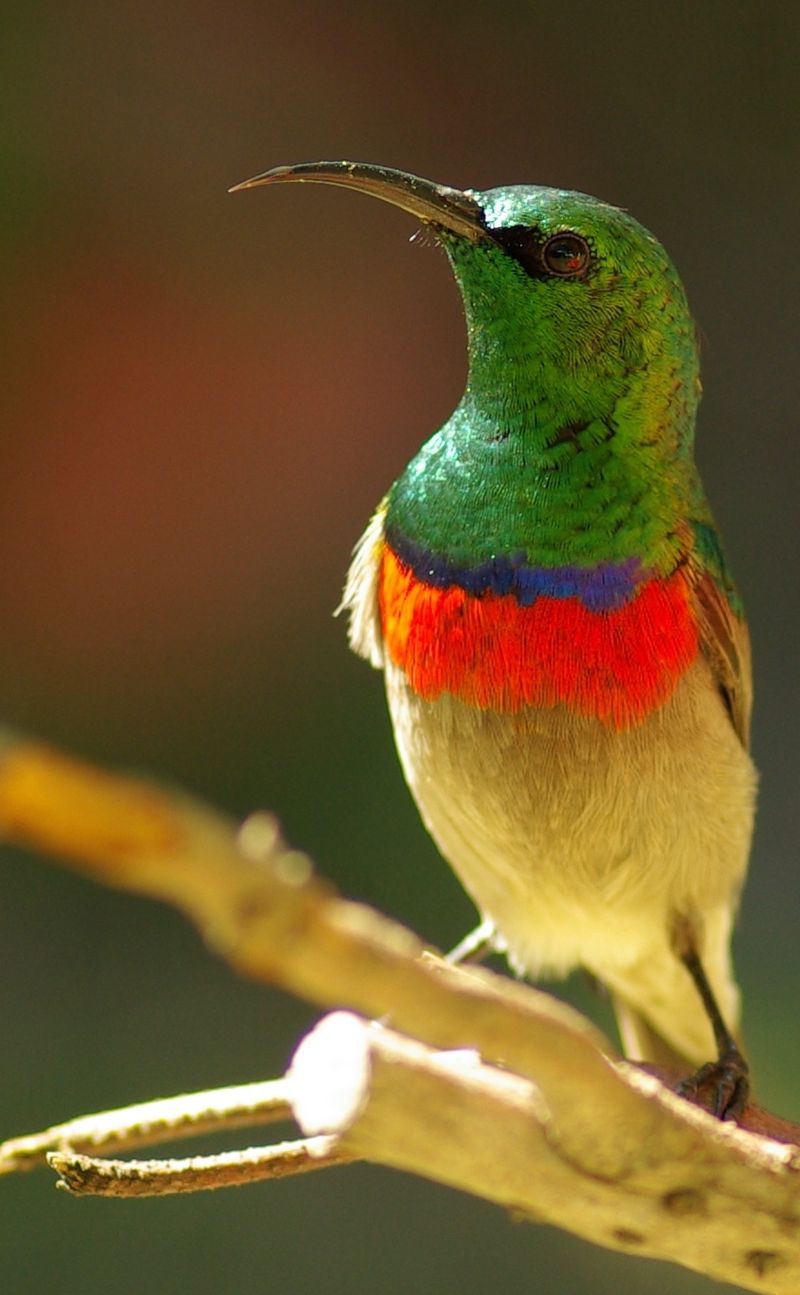
The Southern Double-collared Sunbird is a small passerine bird native to the southern region of Africa. It can often be found in gardens, fynbos, forests and coastal scrub areas.
During breeding season (April to December) its vibrant plumage shines through with golden underparts and a beautiful blue upper body making it one of the most attractive birds around.
They feed on nectar from flowers using their long curved bill as well as insects that they catch in flight or glean from foliage.
These birds are mostly resident but some migrate north east during winter months for better food sources.
With such majestic beauty combined with intelligence this species will continue bring joy to many generations ahead.Scientific classification:
| Kingdom | Animalia |
| Phylum | Chordata |
| Class | Aves |
| Order | Passeriformes |
| Family | Nectariniidae |
| Genus | Cinnyris |
| Species | C. chalybeus |
51. Barratt’s Warbler
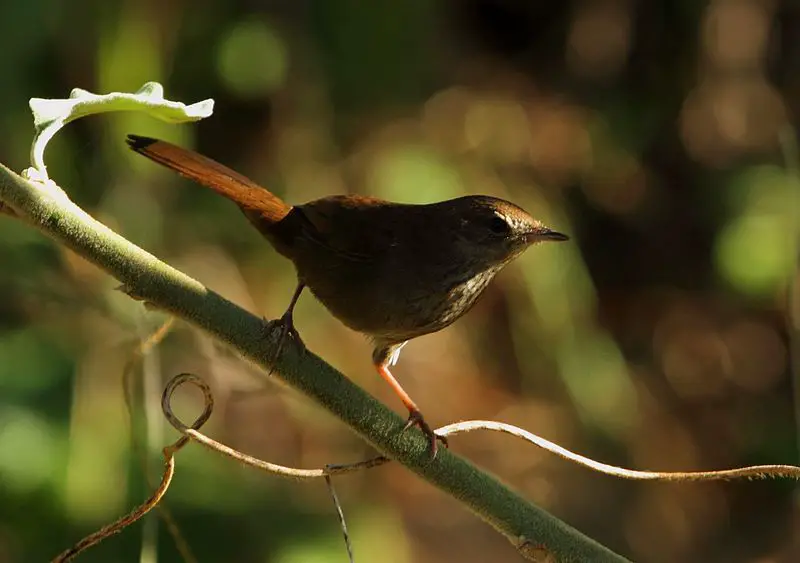
Barratt’s warbler, or African scrub warbler, is a species of Old World Warbler found in eastern South Africa, Lesotho, eastern Zimbabwe and adjacent western Mozambique.
It inhabits subtropical or tropical moist montane forests. This bird was first described by Sharpe in 1876 from the Mac Mac goldfields near Mashishingin Mpuma.
Its plumage is mostly brown with buffy-brown underparts and dark streaks on its back; it also has white stripes above its eyes which give it an angry expression.
The Barratt’s warbler feeds mainly on insects but will eat some fruits as well.
They are active during the day when they can be seen flitting around vegetation looking for food while singing their characteristic song – a series of soft notes followed by two louder ones at intervals.Scientific classification:
| Kingdom | Animalia |
| Phylum | Chordata |
| Class | Aves |
| Order | Passeriformes |
| Family | Locustellidae |
| Genus | Bradypterus |
| Species | B. barratti |